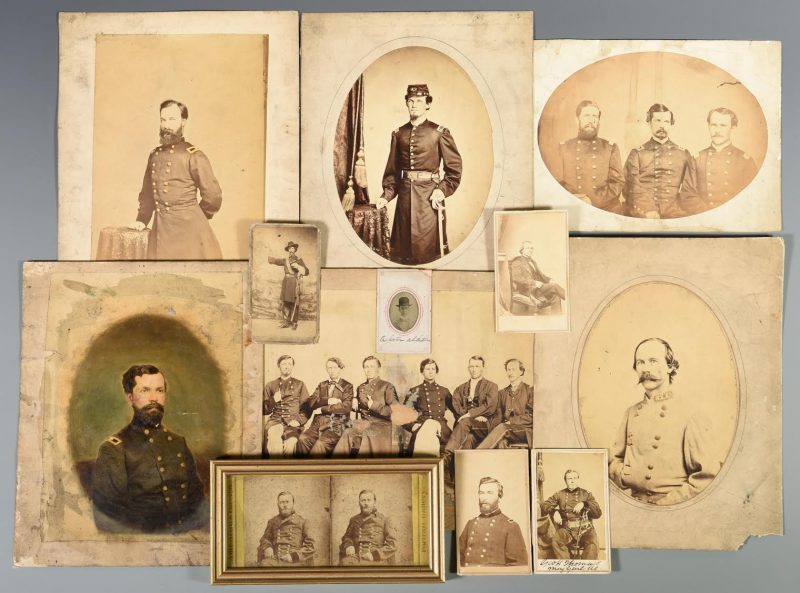 |
|
Extensive Civil War and late 19th century photographic archive from photographer, C. C. Giers (Carl Caspar Giers, 1828-1877, Nashville, Tennessee). Estate of Sarah Hunter Hicks Green, Nashville, TN. |
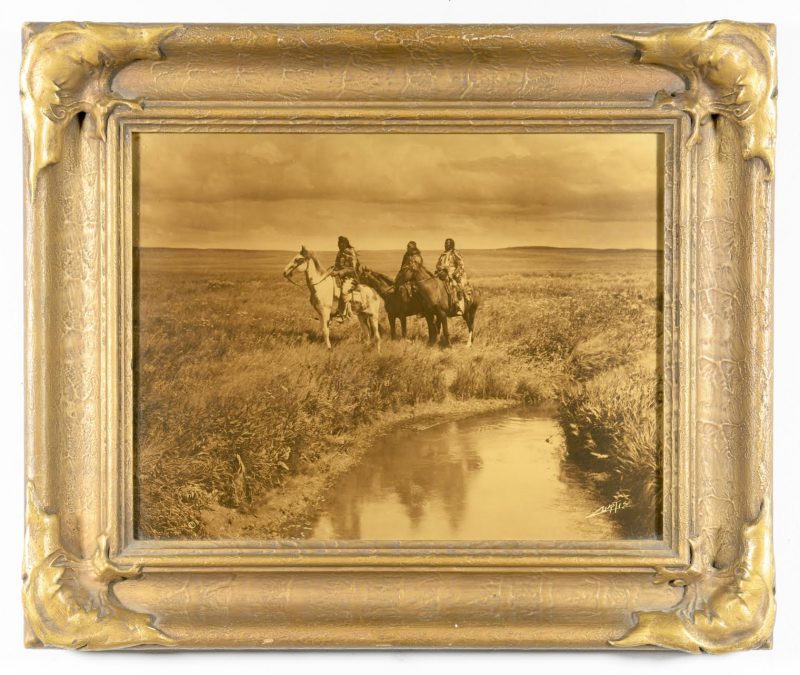 |
|
Edward S. Curtis (American, 1868-1952) orotone titled “The Three Chiefs”. The image depicts three Blackfoot chiefs on horseback against a prairie and sky backdrop, captured during a two week stay on a Blackfoot Reservation in Montana during the summer of 1900. Gold signature in the negative lower right with copyright lower left. Housed in the original molded gilt “Batwing” studio frame designed by Curtis. Orotone is backed by an advertising placard promoting a movie based upon Curtis’s North American Indian project. It reads: “Curtis, Author of the North American Indian tells the intimate story of Indian life with Motion Pictures of esoteric rites Incomparable Art Slides and thrilling musical scenic effects by Mr. Curtis’ Full Orchestra rendering Special Indian Music, arranged by Henry E. Gilbert”. Sight – 10 1/4″ H x 13 1/4″ W. Framed – 15 3/4″ H x 18 3/4″ W. |
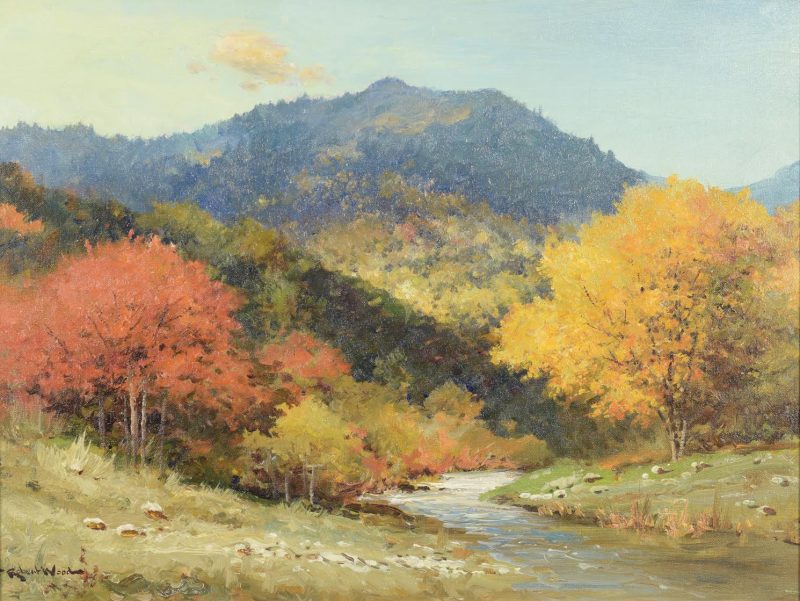 |
|
Robert William Wood (American/1889 – 1979) oil on linen fall landscape scene titled “Smokies” depicting the Smoky Mountains of East Tennessee. Stamped en verso “Reproduction Rights Reserved by Artist/ Painted by Robert Wood” and titled “Smokies”. Signed lower left and housed in a copper painted wood frame. Sight – 17 3/4″ H x 23 3/4″ W. Framed – 20 3/4″ H x 26 3/4″ W. |
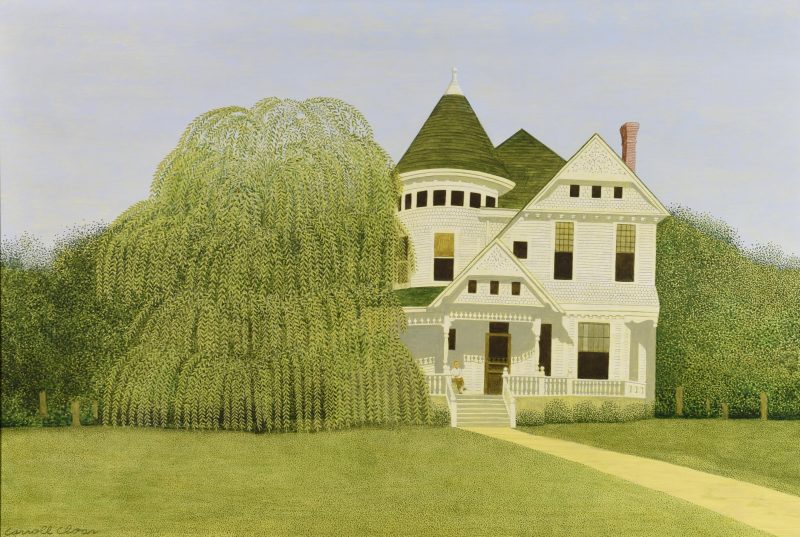 |
|
Carroll Cloar (American/Tennessee, 1913-1993) framed acrylic on board titled verso “The Weeping Willow” and dated July, 1967. Signed lower left corner, “Carroll Cloar”. Landscape depicts a solitary older man sitting on the porch of a white Victorian house with an immaculately clipped lawn in the foreground and expansive weeping willow to the left of the house. Housed in the original painted wooden frame with gilt liner. Sight – 22 1/2″ H x 33 1/2″ W. Framed – 29″ H x 39 1/2″ W. |
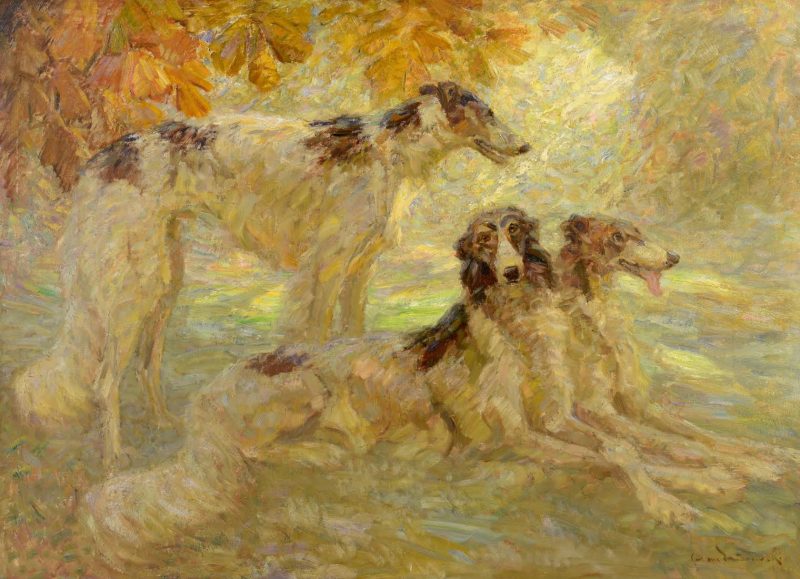 |
|
Large Carl Ritter Von Dombrowski (German, 1872-1951) oil on canvas painting of three Russian wolfhounds or borzoi, in a landscape setting. Signed lower right. Housed in carved and gilded composition frame, likely original: 50-1/2″ H x 64″ W. Sight: 37″ H x 50-1/2″ W. Old paper stamp on back of frame and “10-P-19” penciled and painted on back of stretcher and painted on back of frame. Biography (courtesy Askart: The Artists’ Bluebook): Carl von Dombrowski was the son of an author of hunting literature and became a hunting and nature enthusiast at a young age. He studied in Munich and Vienna at the Academies and worked and lived in Munich after 1919. |
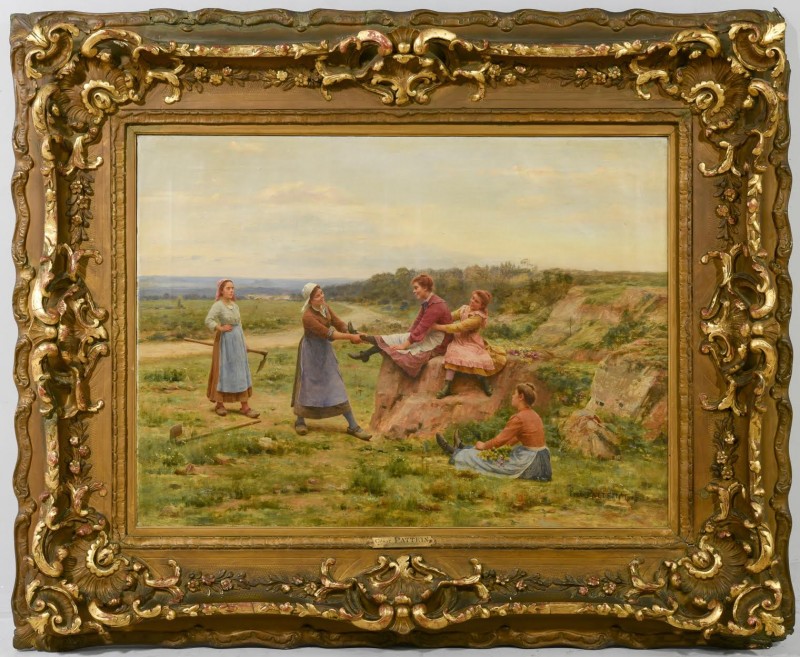 |
|
Cesar Pattein (French, 1850 – 1931) large oil on canvas, titled ” Jeux Champetres (Pastoral Games)”, depicting five young female farm workers taking a break from their work for leisure time. Signed “Cesar Pattein and dated 1907″ lower right. Housed in a gilt carved frame. Sight – 23 1/8″ H x 31 1/4″ W. Framed – 37 3/4″ H x 45 1/2” W. |
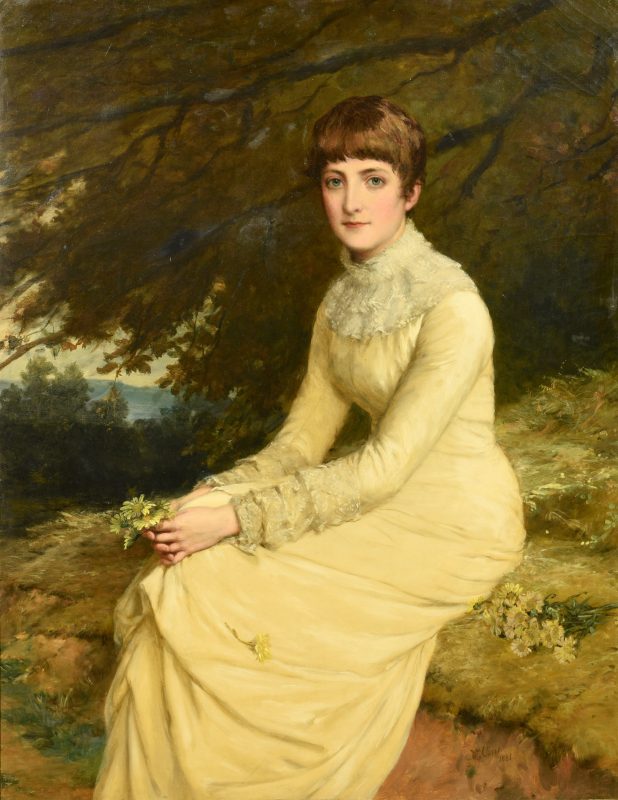 |
|
William Oliver (English, 1823-1901, sometimes referred to as “William Oliver the Younger”) oil on canvas portrait depicting a woman with short brown hair and green eyes, clad in an ivory silk gown with white collar, holding daisies and seated on a rock with tree and landscape in the background. Signed lower right “Wm. Oliver” and dated 1881. Label on back of frame with handwritten inscription “Portrait of Mrs. Temple / Royal Academy 1881 / Harrington Garden South Kensington. ” Original giltwood and composition frame with laurel, egg and dart, and cove moldings. Sight – 35 1/2″ H x 27 1/2″ W. Framed – 49″ H x 41″ W. |
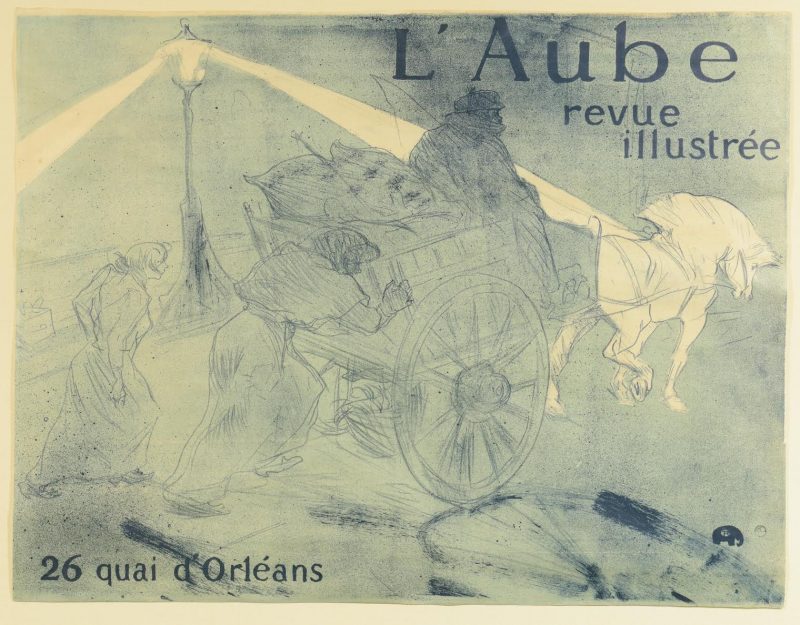 |
|
Toulouse Lautrec, L’Aube Revue Illustree, original color lithograph printed in two shades of blue. Signed in the stone with elephant monogram and monogram stamp lower right. Backed with linen. 23 1/2″ x 30 1/2″ sheet, floated on a cream silk mat in a giltwood molded frame, 33″ x 40 1/2″. Designed as an advertisement for the premiere issue of the art review “L’Aube” in 1896. Catalog ref. Delteil 363, Adhemar 220, Wittrock p. 23, Vol. II p. 802. Only state. Collection of Edwin and Rebecca Raskin, Nashville, Tennessee, purchased from Pasquale Ianetti Galleries, San Francisco, Aug. 1, 1984 (gallery receipt and certificate of authenticity accompanies this lot). |
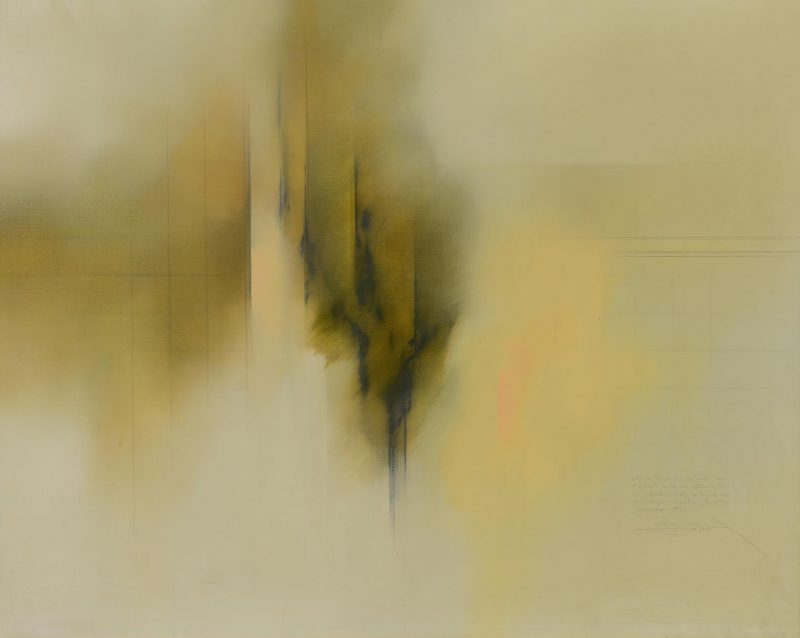 |
|
Fernando Zobel de Ayala Montojo (The Philippines/Spain/Massachussetts, 1924-1984) oil on canvas abstract painting, “Plaza de Pilatos I,” rendered in shades of brown, cream, and light pink. Inscription in Spanish translates: “Afternoon light in the face of Pilate (Casa de Pilatos): from the window of my study, seen through the square, Seville, 31 of December 1972” and signed “Zobel”, in pencil lower right. En verso, signed, titled, and dated. Housed in wooden frame with metallic paint. Sight – 31 1/8″ H x 38 3/4″ W. Framed – 33 1/2″ H x 41 1/8″ W. Provenance: Estate of Robert L. Zarbock, California. More information in coming weeks. |
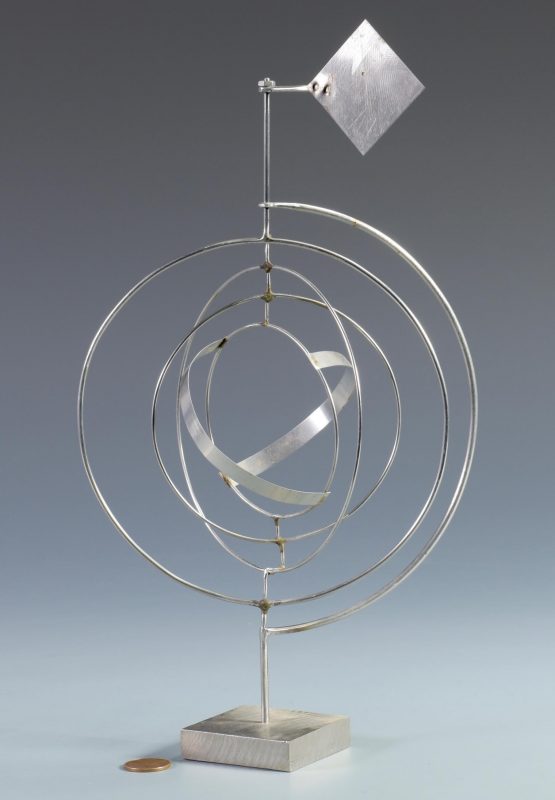 |
|
George Warren Rickey (American, 1907-2002) “Space Churn” steel sculpture, signed and dated. Nashville, TN collection. More information in the coming weeks. |
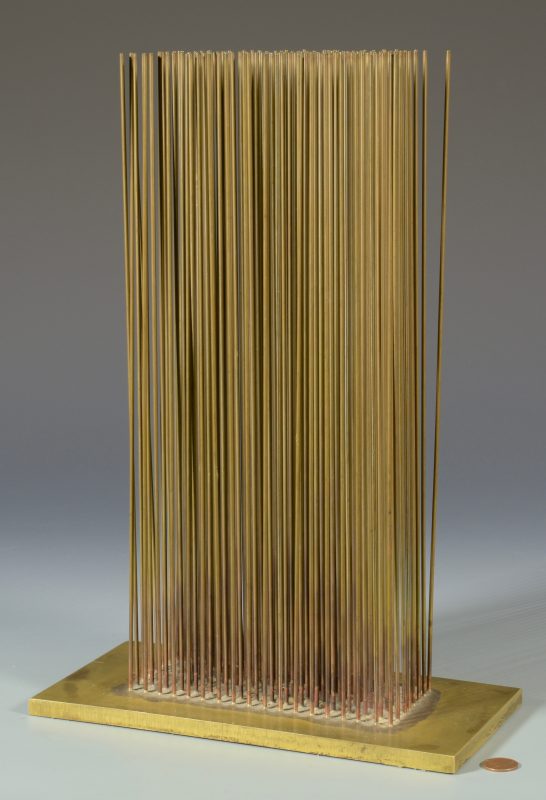 |
|
Harry Bertoia (American, 1915-1978) sound sculpture “Wheat”. 15″H. Nashville, TN collection. More information in the coming weeks. |
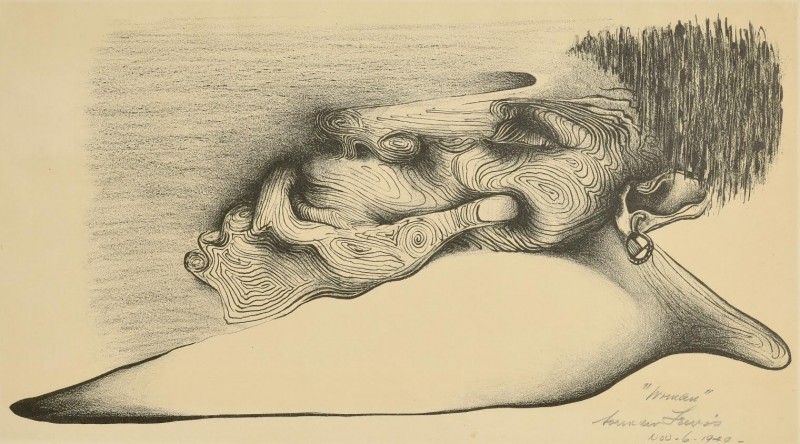 |
|
Norman Wilfred Lewis (New York, 1909-1979) lithograph titled “Woman”. Depicts the head and shoulders of a woman in profile rendered in abstract form, her hand against her jaw in contemplation. Signed “Norman Lewis Nov – 6 – 1944” in pencil, lower right, with a Bertha Schaefer Gallery, New York label on the back. Sight – 8″ H x 14 5/8″ W. Matted – 14 1/8″ H x 19 7/8″ W. Provenance: From the estate of Robert L. Zarbock, Escondido, California. |
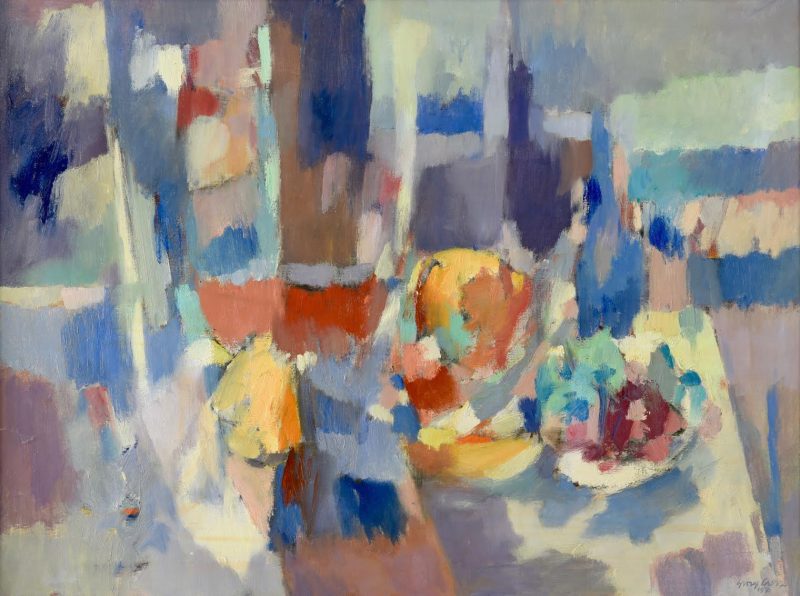 |
|
George Ayers Cress (Alabama/Tennessee, 1921-2008) oil on canvas abstract still life. Signed and dated George Cress ’76 lower right. Housed in a carved gilt wood frame painted with linen liner. Sight: 29 1/2″ H x 39″ W. Framed: 34″ H x 44 1/4″ W. |
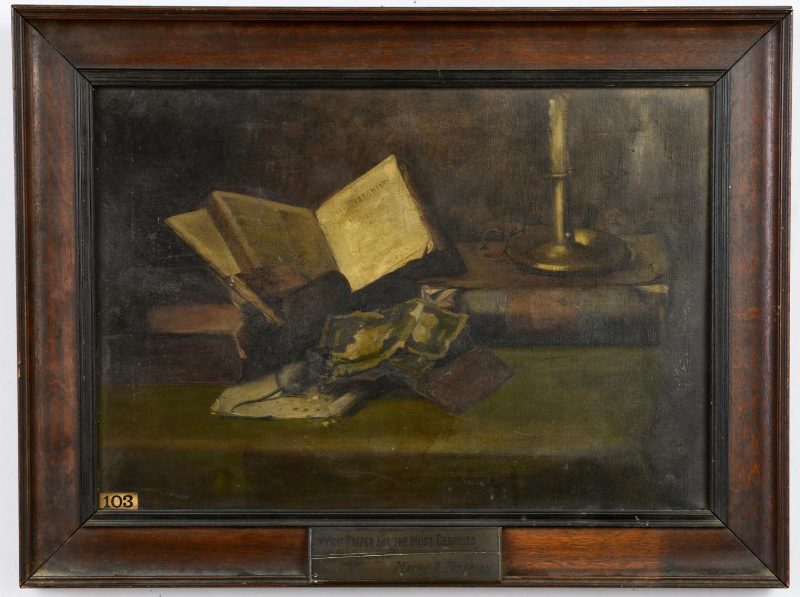 |
|
Tennessee still life oil on canvas titled, “The Most Prized and The Most Despised” by Mayme A. Freeman (Knoxville, TN, b. 1884). This work was awarded the silver medal in the Appalachian Exposition of 1910 held in Knoxville, Tennessee. The still life depicts an open bible atop other books, a candlestick, and a mouse nibbling on money. Signed and dated “Mayme A. Freeman 1910” lower middle right in image. Tag numbered “103” lower left. Housed in a dark wooden frame with mounted wooden plaque listing title and artist.This work is listed and illustrated in the “Catalogue Fine Arts Section Appalachian Exposition” which accompanies this lot. Sight – 17 1/4″ H x 25 1/4″ W. Framed – 23 3/4″ H x 31 1/2″ W. Note: Mayme A. Freeman was listed in a Knoxville, TN 1904 U. S. City Directory under Artists. She was the niece of the famous Knoxville, TN artist Enoch Lloyd Branson (Tennessee, 1853-1925). Her mother was Susan E. Freeman (Branson) daughter of Enoch Branson, sister of Enoch Lloyd Branson. Provenance: Descendant of Branson family. |
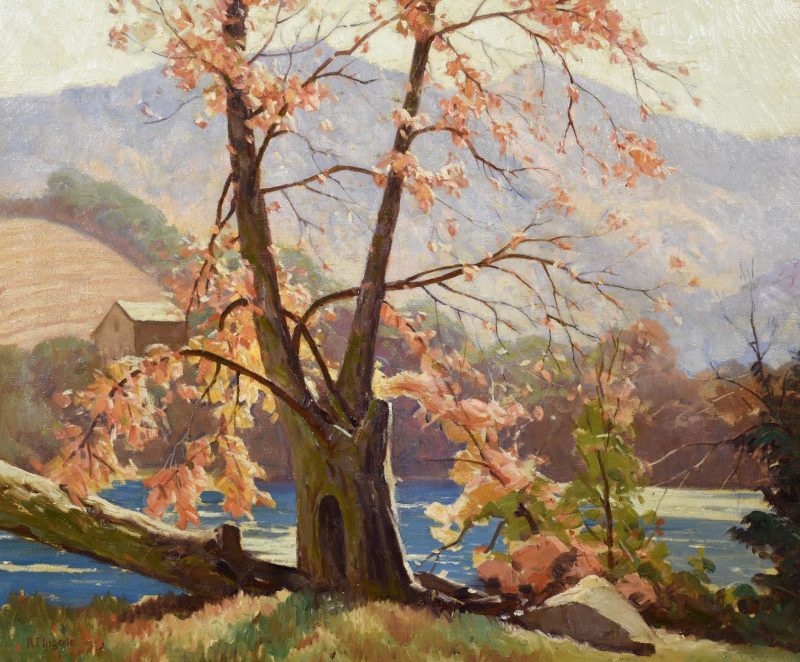 |
|
Rudolph Ingerle (American, 1879-1950), oil on canvas landscape painting, titled “On the Banks of the Tuckaseegee,” 29 1/2″ x 24 1/2″ sight, 37″ x 32″ in giltwood molded frame with acanthus carvings at corners. Artist Biography: Ingerle, sometimes called ‘The Painter of the Smokies’, was born to a Moravian family, immigrated to the U.S. as a child and studied at the Art Institute of Chicago. He was an early founder of the Indiana School of Painting in Brown County and the Society of Ozark Painters. Ingerle first visited the Smoky Mountains in 1920 and fell in love with Eastern Tennessee and Western North Carolina. At that time, the natural beauty of the area was threatened by logging companies. Ingerle painted numerous landscapes there and is among the artists credited with raising awareness of the need for protection, which helped result in the establishment of the Great Smoky Mountains National Park in 1934. His work was exhibited in one man shows at the Mint Museum and Hickory Museum of Art during his lifetime, and was featured in the 2006 Art of Tennessee exhibit at the Frist Center for the Visual Arts. Provenance: Private Nashville, TN collection. |
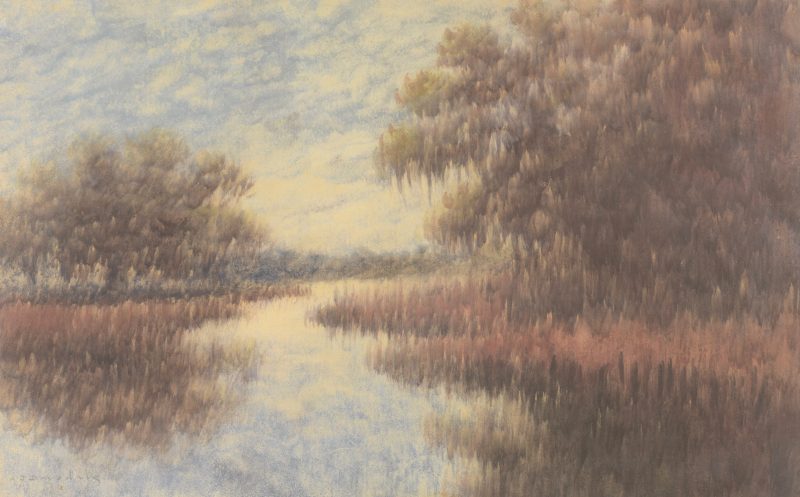 |
|
Alexander John Drysdale (American/Louisiana, 1870-1934) oil wash on paper landscape depicting a Louisiana bayou marsh, signed lower left “A. J. Drysdale”. Housed in the original carved and painted frame. Sight – 19 1/2″H x 31 1/2″W. Framed – 24 5/8″H x 36 3/4″W. |
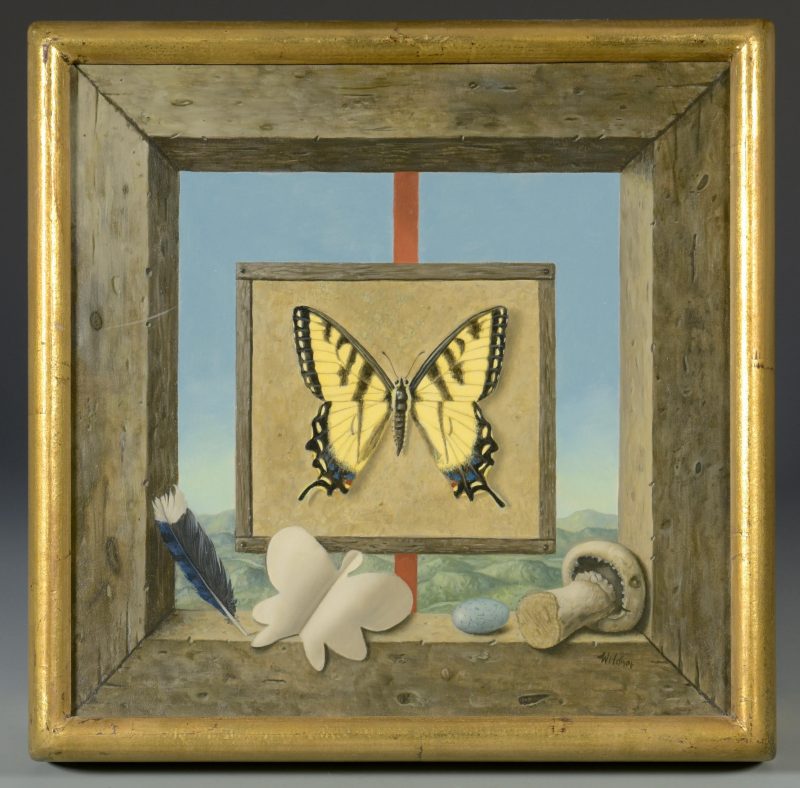 |
|
Werner Wildner (TN, 1925-2004) oil on panel trompe l’oeil painting depicting a butterfly specimen mounted to a board and hung in a window, with a collection of feather, butterfly cutout, robin’s egg and mushroom sitting in the window sill, overlooking a mountainous landscape. Signed “Wildner” lower right. Artist’s mailing address label en verso. Plain molded giltwood frame. Sight – 9″ H x 9″ W. Framed – 10 1/2″ H x 10 1/2″ W. Provenance: Nashville, TN collection. |
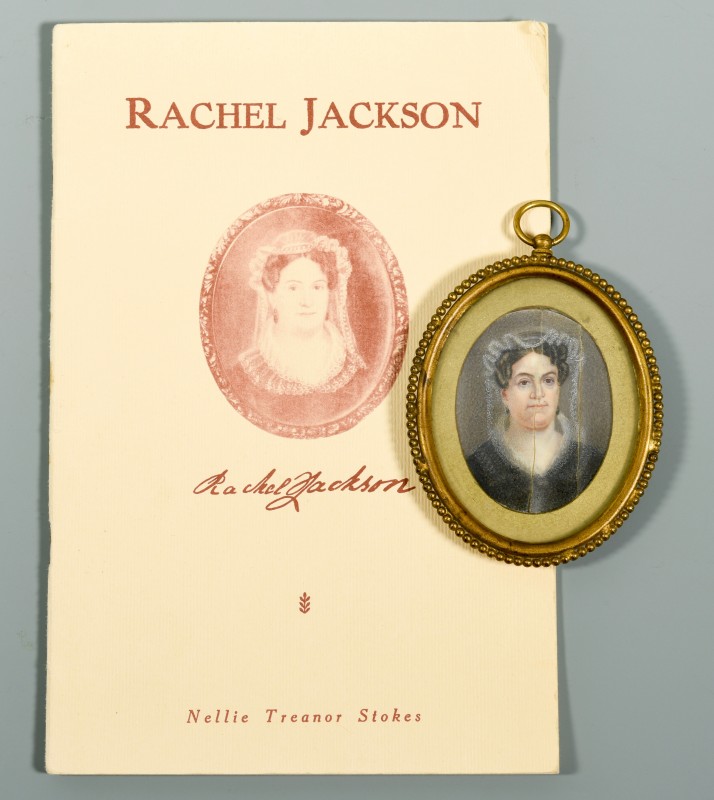 |
|
19th century miniature portrait of Rachel Donelson Jackson (1767-1828), wife of President Andrew Jackson. Mrs. Jackson is depicted in a black dress with white sheer lace collar and bonnet with mantilla. Watercolor on ivory, housed in an oval beaded gilt metal frame (likely later) with gilt mat. 2 3/8″L x 1 3/4″ sight, 3 3/4″ x 3″ framed. Circa 1830. This lot is accompanied by a 1942 biographical booklet on Rachel Jackson by Nellie Treanor Stokes, published by the Ladies Hermitage Association. Rachel Jackson (1767-1828) moved with her family from Virginia to Tennessee as an adolescent (her father, John Donelson, is recognized as the co-founder of Nashville). Her first marriage ended in a divorce of controversial timing, which led to scandal during her second husband, Andrew Jackson’s, presidential campaign. Jackson was elected, but Rachel died of a heart attack shortly before the inauguration. Throughout their marriage, Rachel kept a fairly low profile and spent most of her time in Nashville, running the Jacksons’ home, The Hermitage. Partly as a result of that, her sudden death, and a fire at the Hermitage in 1834, very few portraits of her exist. According to the book “Andrew Jackson: A Portrait Study,” by James G. Barber, only three life portraits of Rachel are known to have been painted: two oil on canvas portraits ( painted in 1825 and 1827, both by Ralph E.W. Earl, both now in the collection of The Hermitage), and one miniature portrait (artist unknown). That miniature is assumed to have been destroyed in the fire. It was referred to in a Jackson letter in 1813, but in 1842, he noted he had no likeness of Rachel or himself from their early years. Only three post-mortem miniatures are mentioned in Barber’s book, all based on the 1827 Earl portrait. Jackson commissioned one of them in 1830 from James B. Longacre, but Jackson angrily sent it back to Longacre when he felt it did not convey Rachel’s likeness (whereabouts currently unknown). Jackson gave the second miniature portrait (circa 1830-1831), to his granddaughter, Rachel Jackson Lawrence as he lay dying (it is now in the collection of The Hermitage). That miniature is signed by Louisa Catherine Strobel, but for many years was misattributed to Anna Peale. Barber’s book states that the third miniature, “now unlocated,” was also misattributed to Anna Peale. In 1941, Fanny O. Walton, who acquired it from her cousin John Lawrence (son of Rachel Jackson Lawrence) offered it for sale to the Ladies Hermitage Association. But the LHHA declined to buy it, believing they already had a Peale miniature. (ref. Barber, p. 229). We believe this is that portrait. Provenance: acquired by consignor from the estate of a Jackson family member. |
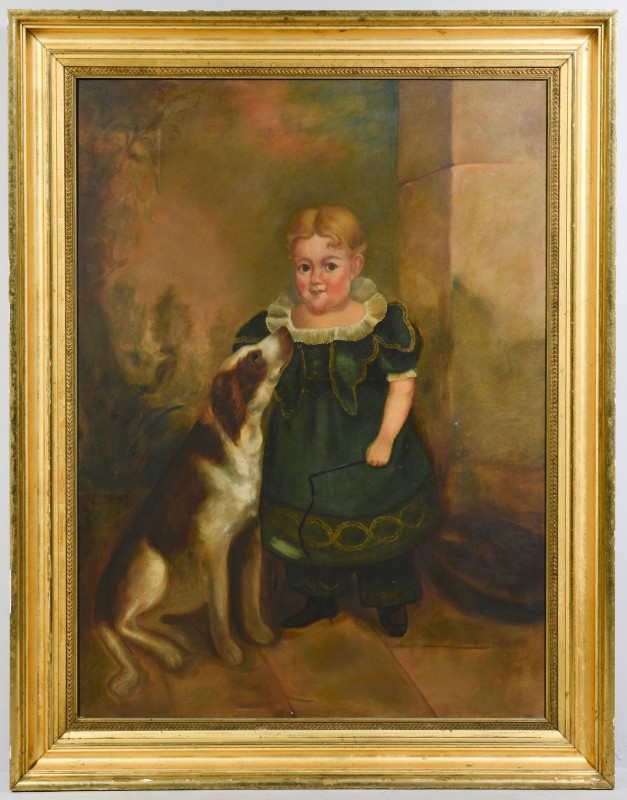 |
|
Oil on canvas portrait of Edward Dickson Hicks as a child (likely Edward Dickson Hicks II, 1831-1894). Depicts the subject at about age 3 in a full-length, standing pose, wearing a green gown with gold trim and white ruffled collar, holding a riding crop in one hand, the other hand resting on his dog. A column and loosely rendered landscape are visible in the background. Unsigned. Original giltwood and composition frame. 48 3/4″ x 36″ sight, 58 1/2″ x 45 1/2″ framed. 19th century. Provenance: the estate of Sarah Hunter Hicks Green, formerly of Historic Devon Farm, Nashville, Tennessee. |
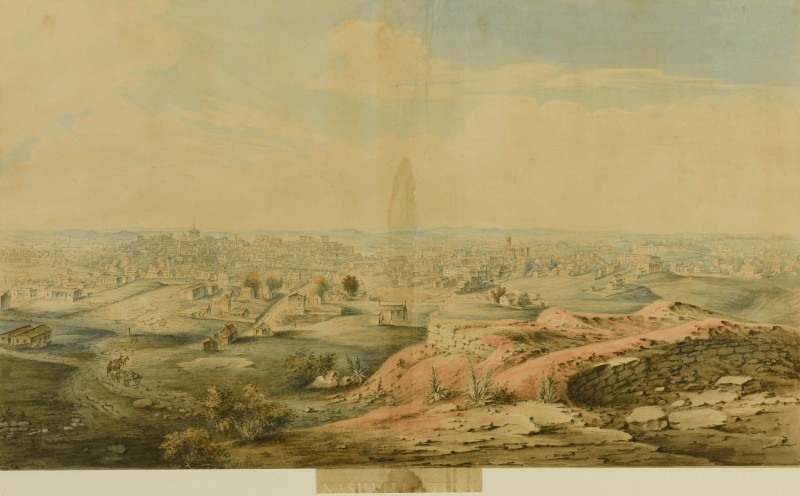 |
|
“Nashville Panorama,” an important and large 19th century watercolor view of the city of Nashville from Fort Negley, painted some time after the Civil War but prior to the devastating fire of 1916. Visible are many Nashville landmarks including the Tennessee State Capitol and the Cumberland River, along with churches, brick and log homes, various figures, horses and carraiges. Unsigned, artist unknown. Titled NASHVILLE TENN. lower margin. 21″ x 36″ sight, 29″ x 42″ matted and framed. Published, “The Tennessee Historical Quarterly: Landscape and Genre Painting in Tennessee, 1810-1985” by James C. Kelly, Tennessee Historical Society, 1985. Exhibited, The Tennessee State Museum, Nashville, Sept. 5-Nov. 20, 1985; Dixon Gallery, Memphis, Dec. 1-Jan. 15, 1986; Hunter Museum of Art, Chattanooga, Feb. 6-March 31, 1986, and the Dulin Gallery of Art, Knoxville, April 10-May 11, 1986. This painting descended in the Hicks-Giers family of Nashville. Estate of Sarah Hunter Hicks Green, Nashville, TN. |
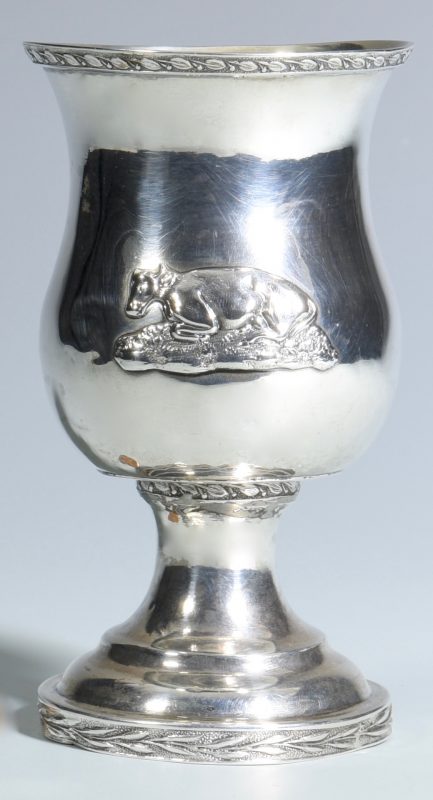 |
|
Devon Farm, Tennessee agricultural coin silver presentation goblet, inscribed ” Premium Awarded by the Tennessee Agricultural and Horticultural Society “, within an engraved wreath cartouche; applied cast cow decoration on the reverse; leaf and berry decorated border repeated beneath the bulbous bowl, raised on a stem spreading to a rounded foot encircled with a decorative band of long, slender leaves. Marked on underside for Bailey & Kitchen (Joseph T. Bailey and Andrew B. Kitchen, working Philadelphia, 1832-1848). 4 7/8″H, 3.335 oz troy. Estate of Sarah Hunter Hicks Green, Nashville, TN. |
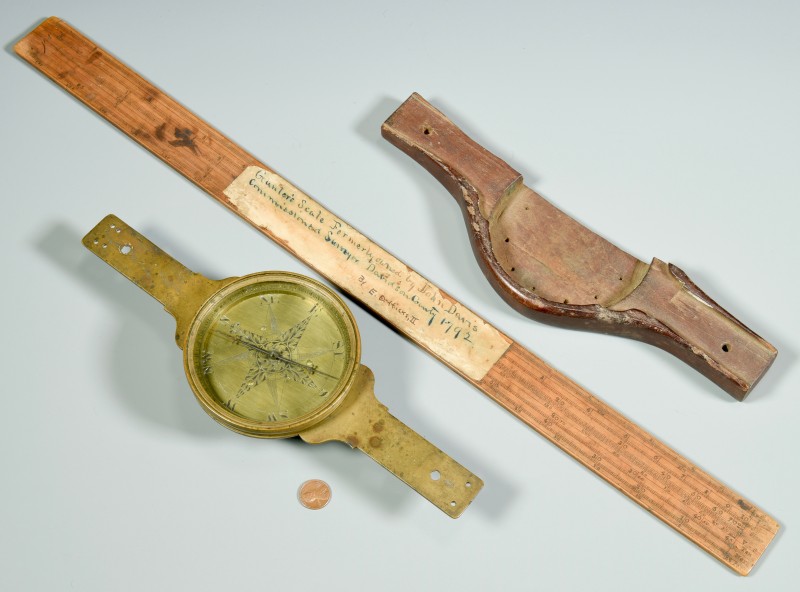 |
|
Brass surveyor compass and Gunter’s Scale used by John Davis to survey Davidson County (Nashville) in the late 18th century. Brass Compass with engraved eight-point dial, with North indicated by a fleur-de-lis; the outer ring is divided into four 90-degree quadrants; steel directional needle on central brass post. No maker’s mark. Retains partial wood cover. Dial 4 1/2″ diameter, overall length 12″. Wooden Gunter’s Scale with incised markings, 24″L; label adhered in the 19th century identifies it as “Gunter’s Scale, formerly owned by John Davis, Commissioned Surveyor, Davidson County 1792.” Note: This instrument, a precursor of the slide rule, was used by surveyors, mechanics, craftsmen, and even retailers to make logarithmic and trigonometric calculations from the 1600s to the late 1800s. Estate of Sarah Hunter Hicks Green, Nashville, TN. |
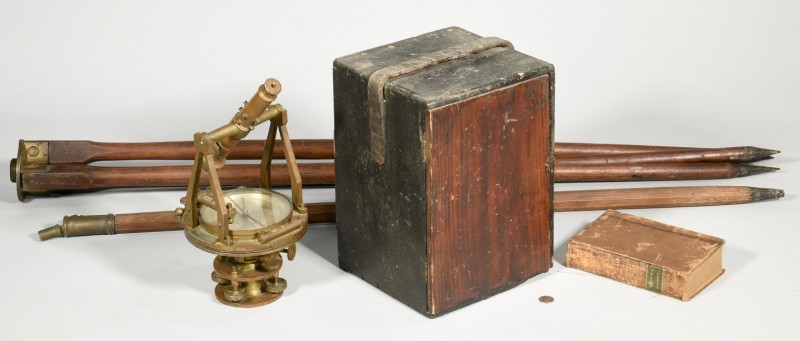
|
|
Tiensch and Stancliff, Louisville Kentucky brass surveyor’s transit level compass on stand, steel dial with engraved name “Tiensch & Stancliff Louisville Ky” and foliate decoration at center. Circa 1859. Adolph Tiensch was born in 1820 in Germany and immigrated to America, setting up shop in Ohio first. He later moved to Louisville, Kentucky in the 1850s, and relocated to Memphis, Tennessee in 1860. He died in 1897 in Memphis. Provenance: estate of Sarah Hunter Hicks Green, Historic Devon Farm, Nashville, believed to have been used by Edward Dickson Hicks II, who took up the trade of his grandfather, John Davis, for a brief period in the mid 19th century. |
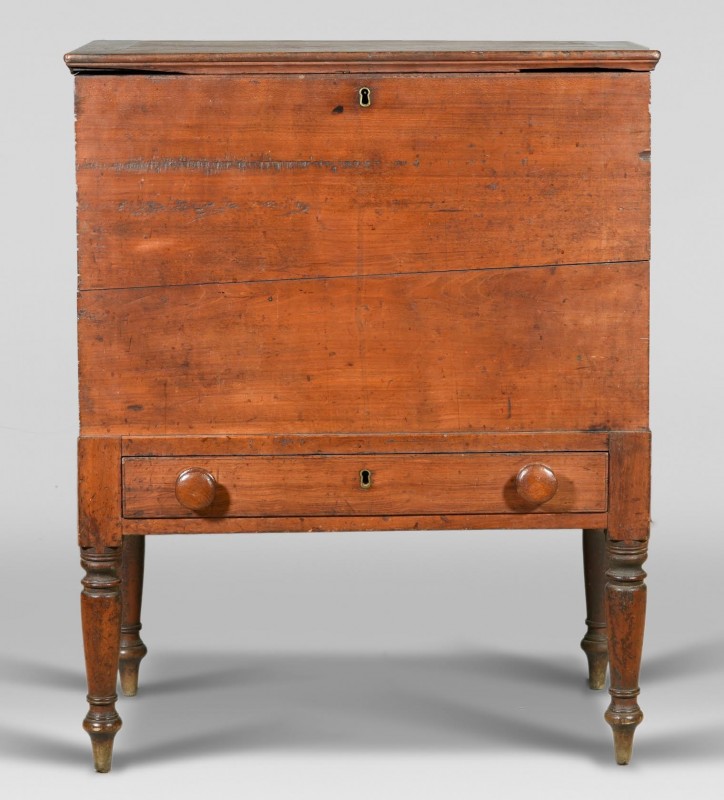 |
|
Tennessee Sheraton walnut sugar chest, poplar secondary. Rectangular molded top with breadboard ends over a deep, dovetailed case divided into one large and two small sections and fitted into a lower section with single dovetailed and scratch beaded drawer. Ring turned and tapered legs ending in spike feet. Retains traces of the old alligatored varnish. Original brass hinges. 36 1/2″ H x 28 1/4″ W x 17″ D. Provenance: the estate of Sarah Hunter Hicks Green, formerly of Historic Devon Farm, Nashville, Tennessee. |
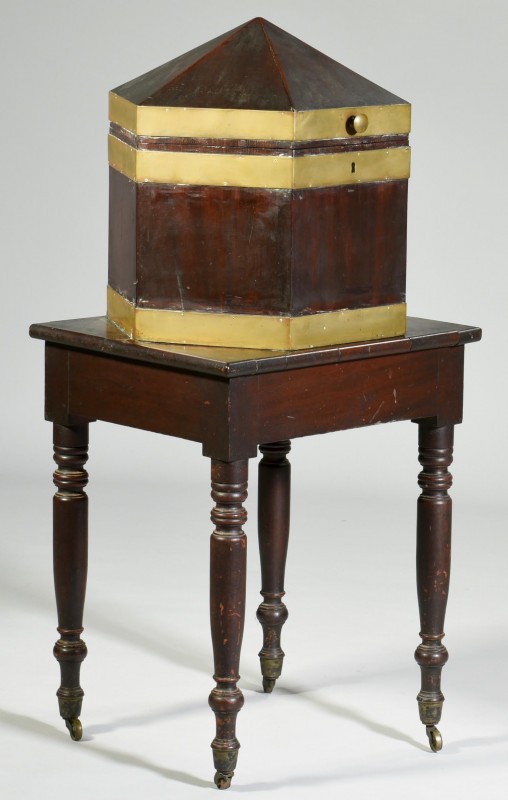 |
|
Southern mahogany hexagonal form brass bound cellarette, in the George III style, with an unusual vaulted top mounted on a Sheraton walnut stand/table with turned legs and brass casters. Table fitted with a thin hexagonal plate, square nailed to the top, to receive the hexagonal cellarette, indicating the cellarette and stand were originally made together. Cellarette measures 17 1/4″ H. Table measures 24 1/2″ H x 19 5/8″ W x 17″ D. Second quarter of the 19th century. Provenance: The estate of Jean A. Yeatman and Harry C. Yeatman, formerly of Hamilton Place Plantation (near Columbia, Tennessee). |
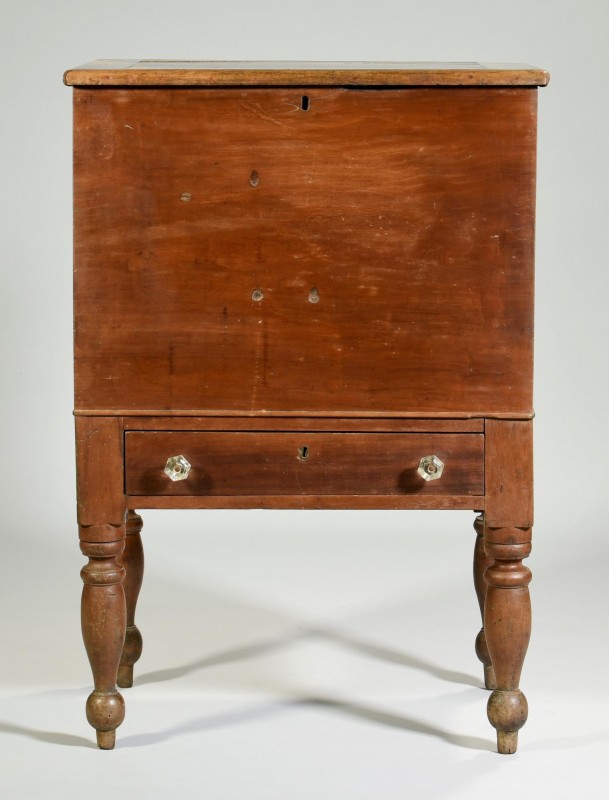 |
|
Tennessee Sheraton sugar chest, cherry primary with poplar secondary, rectangular top with molded lip over a dovetailed case with interior divider, single dovetailed drawer having glass knobs, on tall turned feet. 38 3/4″ H x 27″ W x 20″ D. Circa 1830. Provenance: The estate of Jean A. Yeatman and Harry C. Yeatman, formerly of Hamilton Place Plantation (near Columbia, Tennessee). |
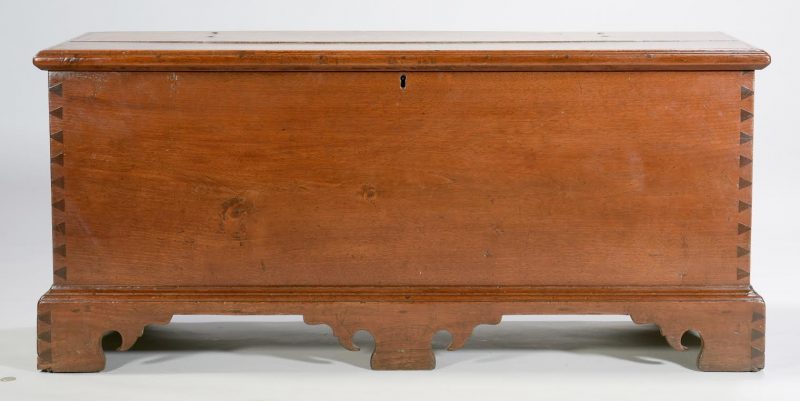 |
|
East Tennessee, Greene County blanket chest, walnut primary and yellow pine secondary, rectangular lid with molded edge, exposed dovetails on case and bracket feet, shaped center foot. Interior till with wrought iron strap hinges. 21 1/4″ H x 47″ W x 18 3/4″ D. Late 18th/Early 19th century. Note: Illustrated in the book “Art & Furniture of East Tennessee”. More information in the coming days. |
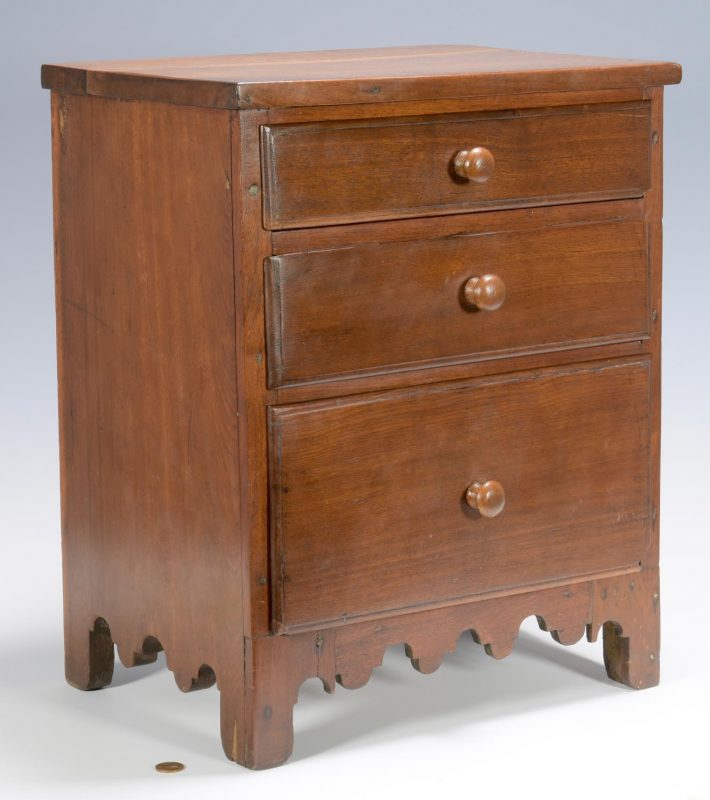 |
|
East Tennessee, possibly Hamblen County, miniature cherry/walnut chest of drawers, poplar secondary, square nail construction, comprised of three (3) graduated dovetailed drawers with lipped edges, scalloped apron and returns, bracket feet. Drawers with wooden knobs. 18″ H x 14 1/4″ W x 10 1/4″ D. Second quarter of the 19th century. |
|
|
|
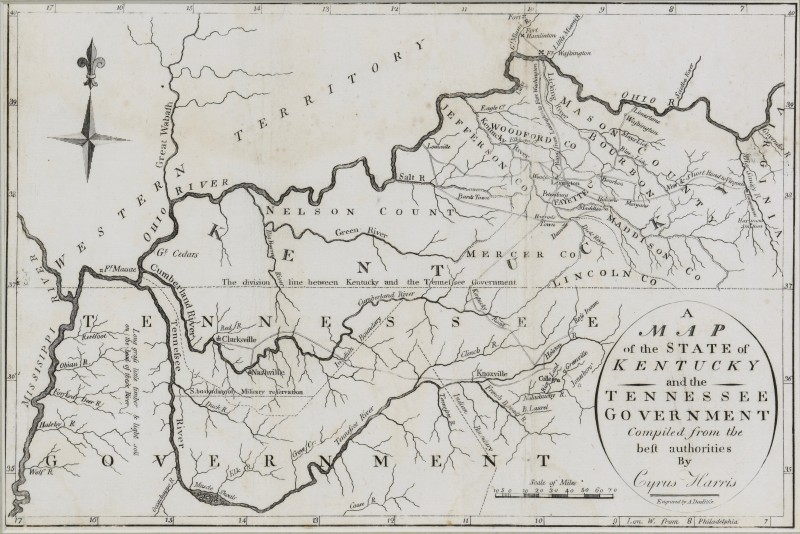 |
|
1796 hand-colored map of the State of Kentucky and the Tennessee government, “Thomas & Andrews. Boston. Compiled from the best authorities by Cyrus Harris. Engraved by A. Doolittle” Sight: 8″ H x 11-15/16″ W. Nashville, TN Collection. |
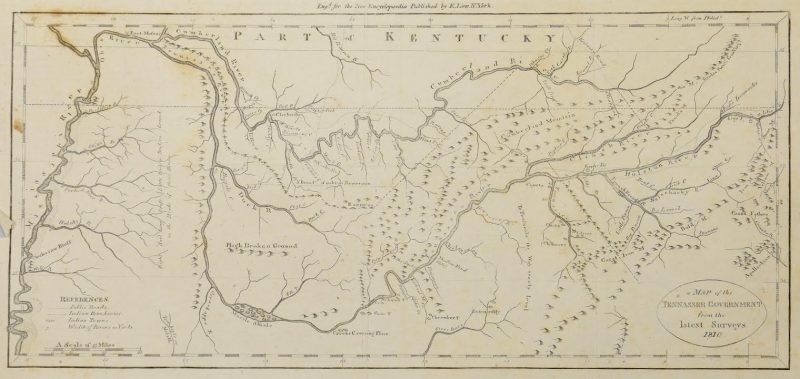 |
|
“A Map of the Tennassee [sic] Government from the latest Surveys 1810” by John Payne for his New and Complete Universal Geography, Volume 4, America, published by E. Low, New York. Uncolored map of early Tennessee featuring early towns and roads, including Knoxville, Nashville, and “Clerksville” (Clarksville), Native American towns and roads, boundary lines, rivers, mountain ranges, and remarks about the land including the inscription “Light Soil Long Grass. Little Timber. Broken Ground. on the Heads of these Rivers.” vertical across the area of Western Tennessee. Title cartouche, lower right, references legend, lower left, scale of miles, lower left. “Engd. for the New Encyclopaedia Published by E. Low N. York” centered above map, “Long. W. from Philada.” top right. Map surrounded by scale notations and black line border. Plate – 7 1/2″ H x 16″ W. Sheet – 9 3/4″ H x 16 7/8″ L. |
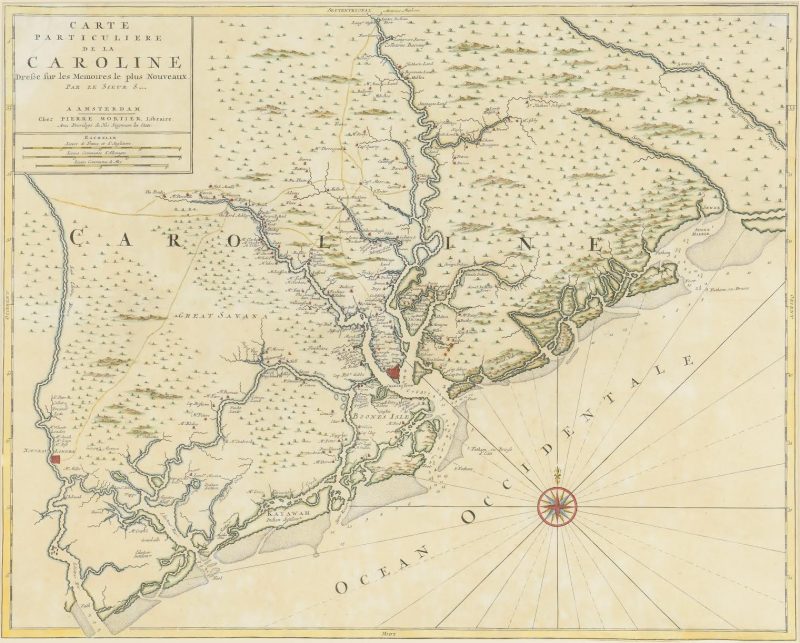 |
|
Pierre Mortier / Nicolas Sanson, CARTE PARTICULIERE DE LA CAROLINE, DRESSE FUR LES MEMOIRES LE PLUS NOUVEAUX, published Amsterdam, circa 1696. Copper engraving with hand colored highlights. The first map of South Carolina printed in Continental Europe. 19″ x 23 1/2″ sight, 28″ x 32″ with cream silk mat in ebonized frame with gilt liner. Scarce map of the coastal region around Charleston and the Cooper River, depicting the area from the Santee River in the North to the Edisto River in the south. It shows several early roads and Indian settlements, as well as names and locations of dozens of early landowners, including the Santee and Sewel Indian Forts, the Kayawah ( Kiawah ) Indian Settlement, and Colletons Barony along the Cooper River. (Sir John Colleton was one of the eight proprietors of the Carolina Grant, a member of the Council for Foreign Plantations and of the Royal African Company, which introduced slavery into the British possessions in North America). This map is generally regarded as the first obtainable map of the region to appear in a commercial atlas. Cumming 121, Kendall Early Maps of Carolina 17C. Provenance: Nashville private collection, acquired several years ago from Carolina Prints, Charleston, South Carolina. |
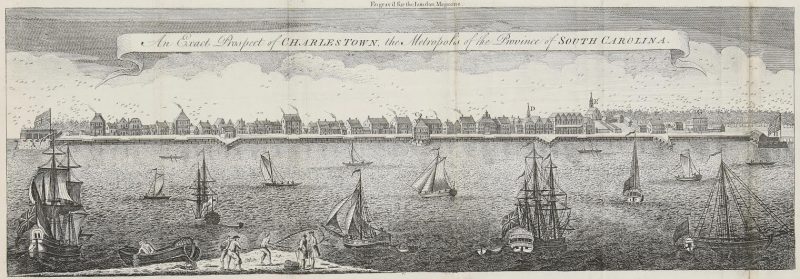 |
|
Early English engraved map depicting Charleston, South Carolina, titled “An Exact Prospect of Charlestown, the Metropolis of the Province of South Carolina”, after the painting by Bishop Roberts. Engraved by William Henry Toms for London Magazine and published in 1779, 2nd edition. Unframed. 8 1/4″ H x 21 3/4″ W. Note: The 1st edition map was published in 1762 with very minor differences. |
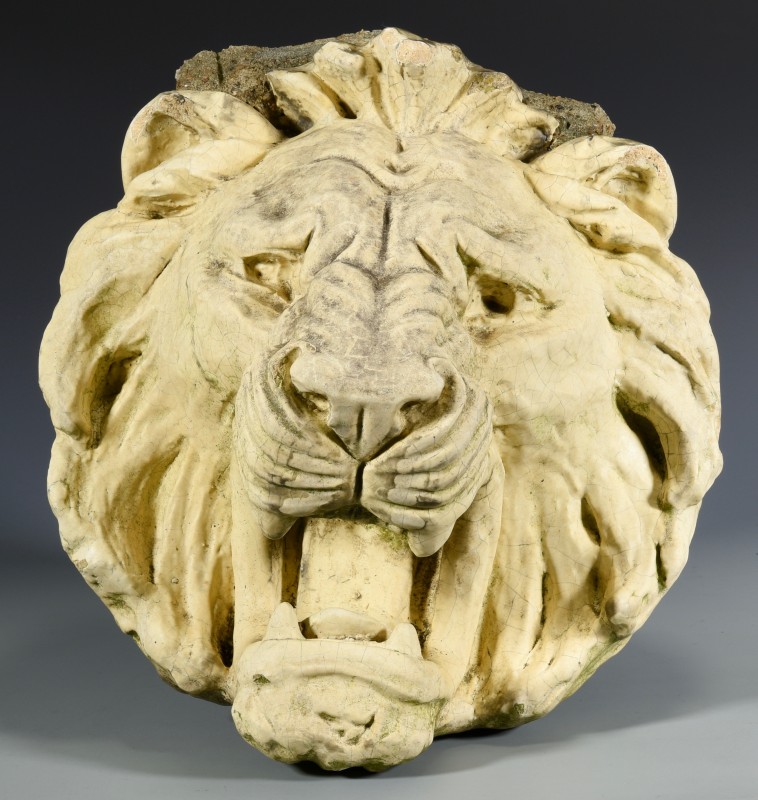 |
|
Architectural ornament from Hermitage Hotel, Nashville, TN, large molded terracotta head of roaring lion, painted cream with concrete remnant on back. Impressed numbers on back. 12-1/2″ H x 17-3/4″ D overall x 15-1/2″ W. Circa 1910. The Hermitage Hotel, a landmark in downtown Nashville, was designed by Middle Tennessee architect J.E.R. Carpenter and finished in 1910. It has lodged a who’s who of American politicians, entertainment personalities, and foreign dignitaries, and it was listed on the National Register of Historic Places in 1975. One of the most notable features of the Beaux Arts style hotel is the polychromed terra cotta architectural ornamentation found at the base, top floor and roof cornice. Around 2001, restorations were made to the projecting cornice and some pieces were removed and replaced with fiberglass reproductions. Some of the original intact architectural elements were made available to Historic Nashville Inc., including this lion head, which is being sold along with its original certificate of authenticity from Historic Nashville Inc. |
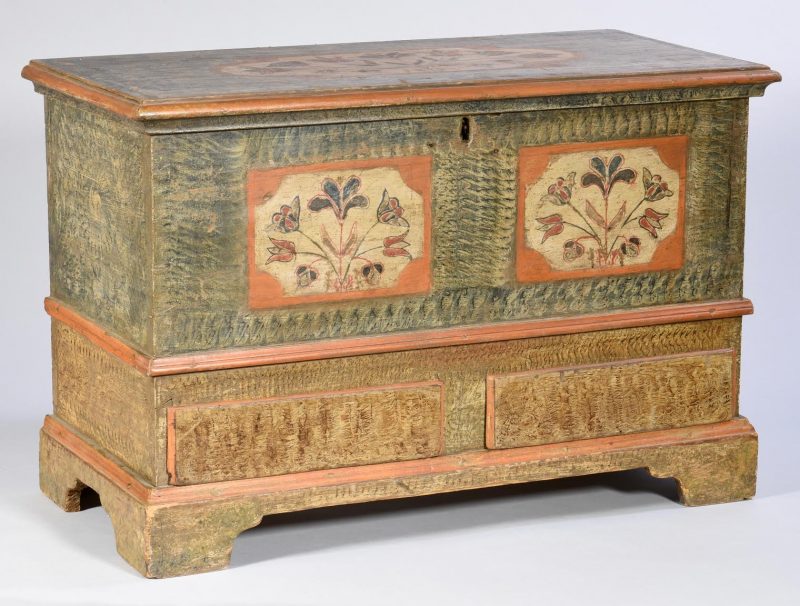 |
|
Child’s polychrome paint-decorated pine blanket chest, attributed to “the Scraggly Artist,” Montgomery-Berks County, Pennsylvania border. Molded, hinged top with blue-green sponge painted decoration, surrounding a central cartouche decorated with a spray of tulips, free-hand painted in dark blue, red and yellow, and outlined in a salmon border. The tulip decoration is repeated in two side-by-side painted panels on the front of the dovetailed case, which sits atop a lower section with two drawers, and a base having ochre sponge painted decoration extending onto dovetailed bracket feet. Back is plain and unpainted. Case sections and base are divided by applied bands of molding in solid salmon paint. Interior well has lift top till. Drawers are constructed with wedge-pin dovetails, and one is dated “1800” in salmon paint on the exterior side. 19 1/4″ H x 28″ W x 14″ D. Provenance: private Tennessee collection, found in Alabama. This chest is attributed to the so-called “Scraggly Artist,” a term coined by Monroe Fabian in his book “The Pennsylvania-German Decorated Chest,” to describe an unknown artisan whose paint decoration is executed in a similar “disheveled, yet controlled” style (for similar examples see figs. 150 & 151). According to Lisa Minardi, assistant curator at Winterthur Museum and a specialist in Pennsylvania German art and culture, few chests of this diminutive size and by this artist have been found, and only a couple of other chests by this artist bear dates. For a similarly decorated miniature chest, attributed to Lehigh Valley, refer to the sale of the Richard and Rosemarie Machmer collection, Pook and Pook Auction, Oct. 24-25, 2008, lot 608. Another similarly decorated miniature chest, attributed to Berks County, was sold in Sotheby’s auction of American Folk Art from the Sandy and Julie Palley collection, Jan. 18, 2002, lot 931. |
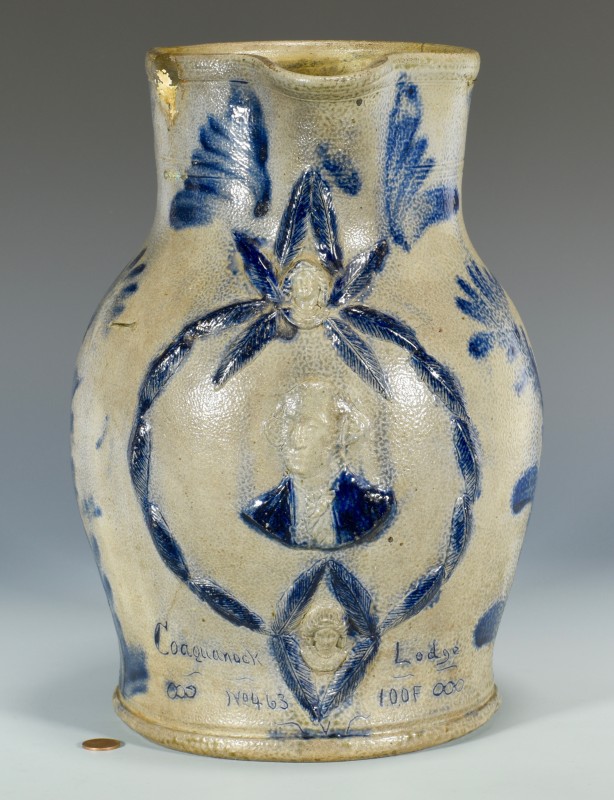 |
|
Large Philadelphia cobalt decorated stoneware presentation pitcher, attributed to Richard C. Remmey, with applied relief molded bust decoration of George Washington, encircled by an applied relief molded wreath beneath the spout, along with two smaller relief molded female busts above and below, possibly emblematic of Fortune and/or Lady Liberty. Incised script with cobalt highlights near base, “Coaquanock Lodge No. 463, I.O.O.F.” with the I.O.O. F. circle symbol flanking both sides of the inscription. Extensive cobalt floral decoration to both sides of body depicting leafy stems branching into two flower heads with additional leaf/feather decoration below the rim and flanking the spout. 13 3/8″ H. Second half 19th century, possibly made to coincide with Washington’s Centennial inauguration celebration. Note: A relief molded Washington pottery pitcher having decoration similar to this example can be found in “Decorated Stoneware Pottery of North America” by Donald Blake Webster, page 151, illustration 190. Biography (courtesy The American Odd Fellow, Volume 3, by John W. Orr, page 18, 1864): “Coaquanock Lodge, No. 463, was instituted on the 4th of March, 1852, in [Philadelphia], by the Grand Lodge of Pennsylvania, since which time it has relieved 150 brothers in distress and sickness; 30 widowed families; and buried 15 brothers. Its present number of members in good standing is 122, principally of young men.” Records for this lodge date until 1925. Provenance: Private Tennessee collection. |
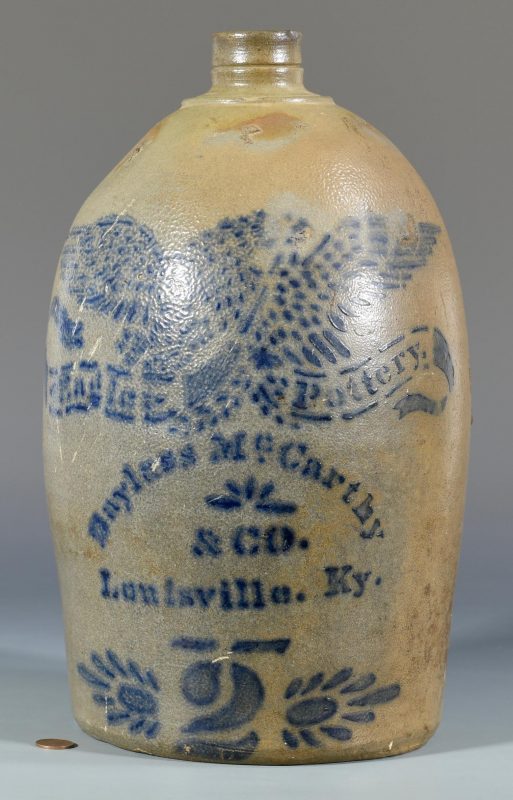 |
|
Bayless McCarthy & Company, Louisville, KY stoneware advertising jug, 2 gallon size with stenciled cobalt eagle decoration. Eagle holds a banner reading “Eagle Pottery” above the stenciled words “Bayless McCarthy & Co. Louisville. Ky.” and “2” (denoting size) flanked by stenciled floral motifs. 14 1/4″ H. Last quarter 19th century. |
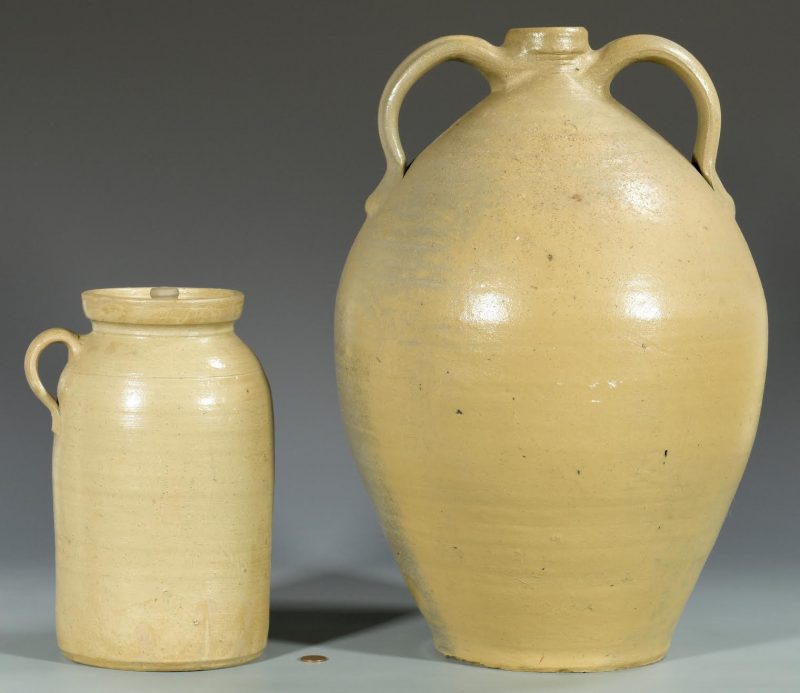 |
|
1st item: Daniel Cribbs (1800 – 1892/Tuscaloosa, Alabama) double handled salt glazed stoneware jug with thin light colored slip beneath the glaze. Stamped below the neck “Daniel Cribbs, Tuscaloosa” with and incised “5”, denoting gallon capacity. 18″ H. 2nd item: Unmarked, salt glazed stoneware handled preserving jar with lid, attributed to Daniel Cribbs. Note the “triangular” tapering of the handle of this jar, handle, and glaze are very similar to the marked double handled jug. Both forms were found at the same location. 10 1/2″ H. |
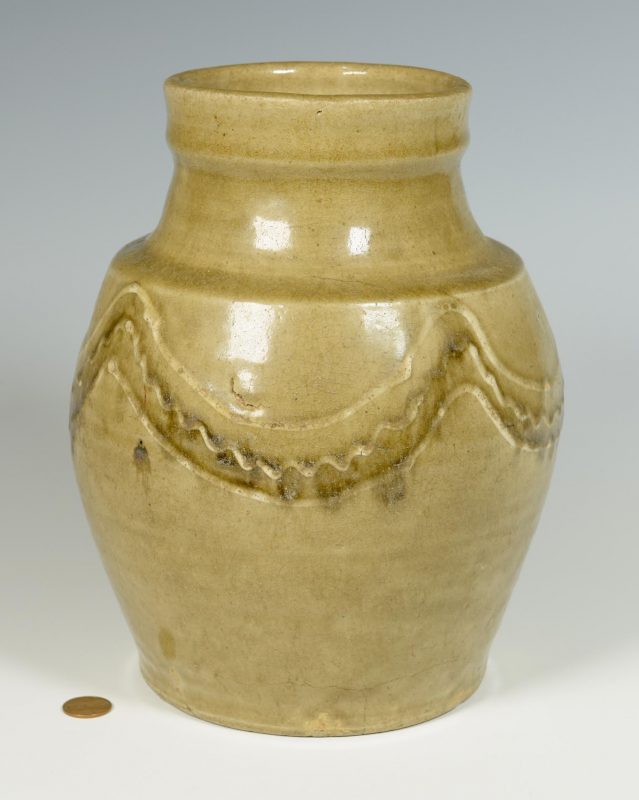 |
|
South Carolina Edgefield alkaline glaze pottery storage jar, having a squared rim, prominent shoulder and slip garland or swag decoration to the body. 9 1/4″ H. 3rd quarter 19th century. |
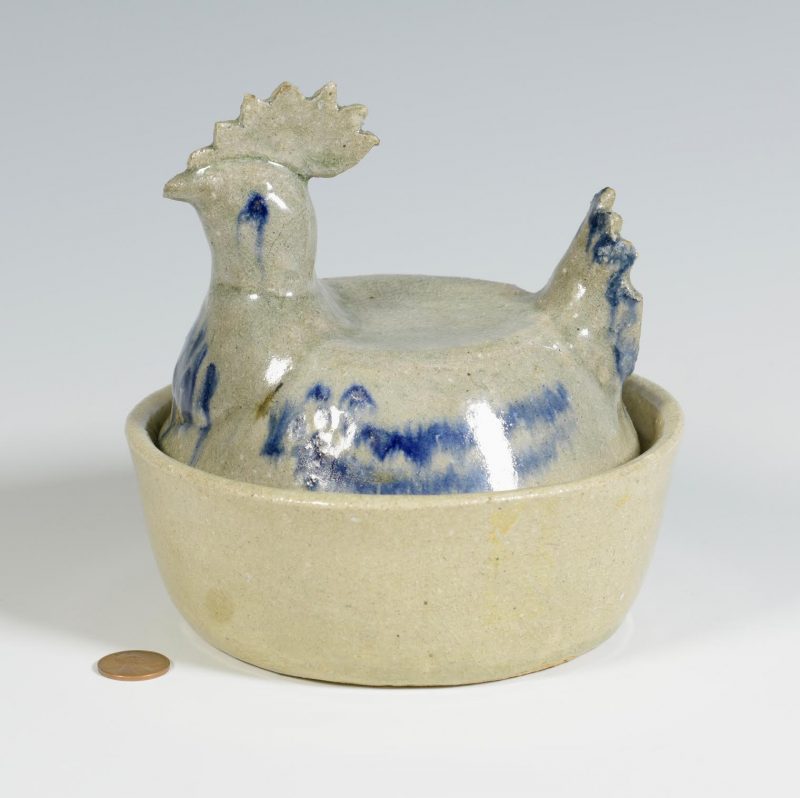 |
|
Arie Meaders (Georgia, 1897-1989) covered “chicken bowl” comprised of a bowl with figural rooster lid, both having a light tan alkaline glaze with cobalt accents to the rooster body, face and tail. Incised initials “A M” to the base along with a written museum catalog number “68.216 GA” to the underside of lid and base. 6 3/4″H x 6″ W. 20th century. Provenance: From the collection of Malcolm Watkins (1911-2001), head curator of the Department of Natural History, Smithsonian Museum. |
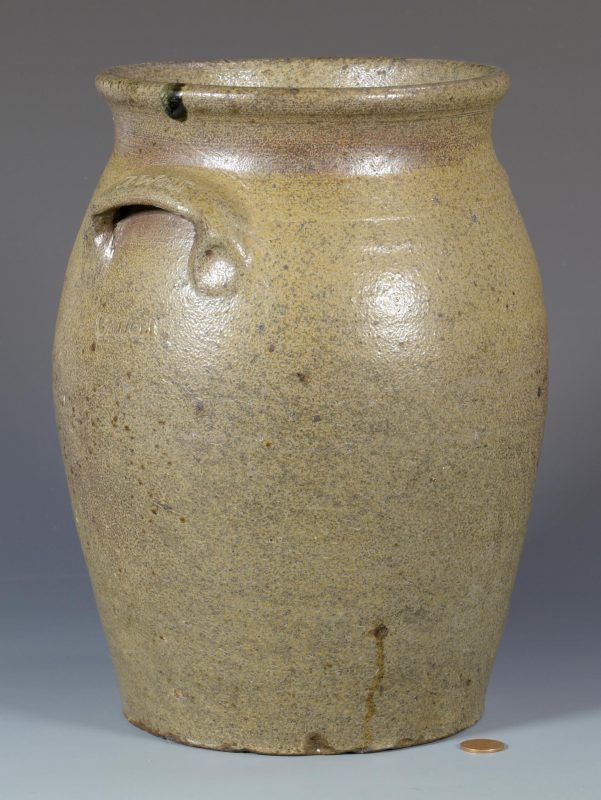 |
|
Rare 19th century North Carolina salt-glazed stoneware pottery jar stamped “G. Wolf” on one lug handle with an additional “G. Wolf” stamp below the handle. 11 1/4″ H. Attributed to Gaston B. Wolf who was born in 1837 in Orange County, North Carolina. His father, William, in North Carolina; uncle, Peter, in Washington County, Virginia; cousin, William, in Lee and Wise counties, Virginia (Wise was formed from part of Lee County in 1856); and uncle, Benjamin Phillips, in Carroll County, Tennessee were all potters. At the time of the 1860 census, Gaston was living in Orange County with his parents, four brothers and one sister. On June 21, 1861, at the age of 23, he and a younger brother enlisted in Alamance County in the 6th North Carolina Infantry, Company K (Confederate). Within 8 months an older brother also enlisted in Company K. Neither of his brothers survived the war. Gaston was free to leave the Confederate Army and return home May 22, 1865. He married Ellen Cates in Person County on November 20, 1867. Ella/Ellen/Penelope Wilson Cates was a widow with two children. It appears that at the time of the 1870 Person County census Gaston, Ellen and children were living where Ellen had lived in 1860 (family 140). Gaston’s father, William, and two of his children lived nearby (family 165). Ellen’s parents and a married brother were families 163 and 164. Both Gaston and his father were listed as “Potter” in 1870. It is not clear if they potted together nor where the pottery or potteries were located. Gaston’s father was not found in the 1880 census. If living, he would have been about 73 years of age. Gaston, Penelope (Pernalaper in census) and children were still in Person County in 1880. Gaston’s occupation was recorded as “Farming”. This does not necessarily mean that Gaston no longer potted. Potters frequently referred to themselves as farmers if they farmed as well as potted. It is possible that a younger brother, George Franklin, may have potted. A jar stamped G. F. Wolf and 1887 is known and has been attributed to him. The stamp is very similar to this jar’s stamp. It is not known whether it was made while working with Gaston. George Franklin was never found living in Person County. He was, however, found in Alamance County in 1880. Some descendants believe that Gaston lived until the late 1890s (Research courtesy of Carole C. Wahler). |
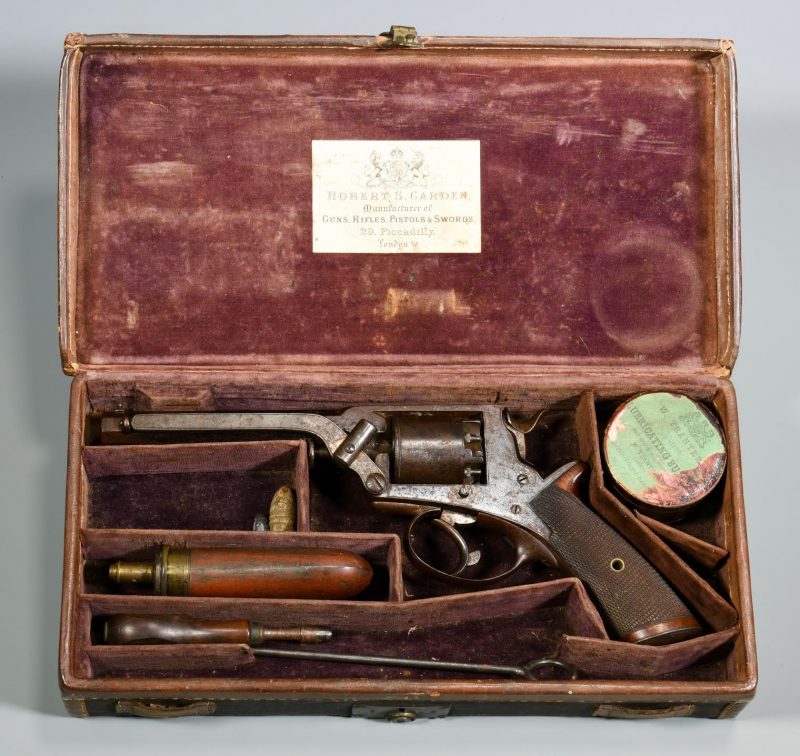 |
|
Tranter Revolver, .44 caliber, serial number No. 12959 T, Side Arm of Lt. Colonel Henry Clay Yeatman, Cased with Accoutrements. Name of retailer stamped on top of barrel R. S. GARDEN. 29 PICCADILLY. LONDON. Barrel length – 6″. Overall length – 12 1/4″. Housed in original English leather box with Robert S. Garden label inside of lid. Inside of box lined with brown velvet and partitioned to hold tin of Tranter patented lubricating bullets, cleaning rod and nipple wrench, and unmarked bag flask. Box – 2 3/4″ H x 14″ W x 7″ D. Included is a copy of “North South Trader” Vol. XI, No. 2, Jan-Feb 1984, with article by Ted P. Yeatman in which he discusses the Tranter Revolver’s history. The revolver was used during the Civil War by Lt. Colonel Henry Clay Yeatman, his great-grandfather. Article on pages 25-26. Provenance: The estate of Jean A. Yeatman and Harry C. Yeatman, formerly of Hamilton Place Plantation (near Columbia, Tennessee). |
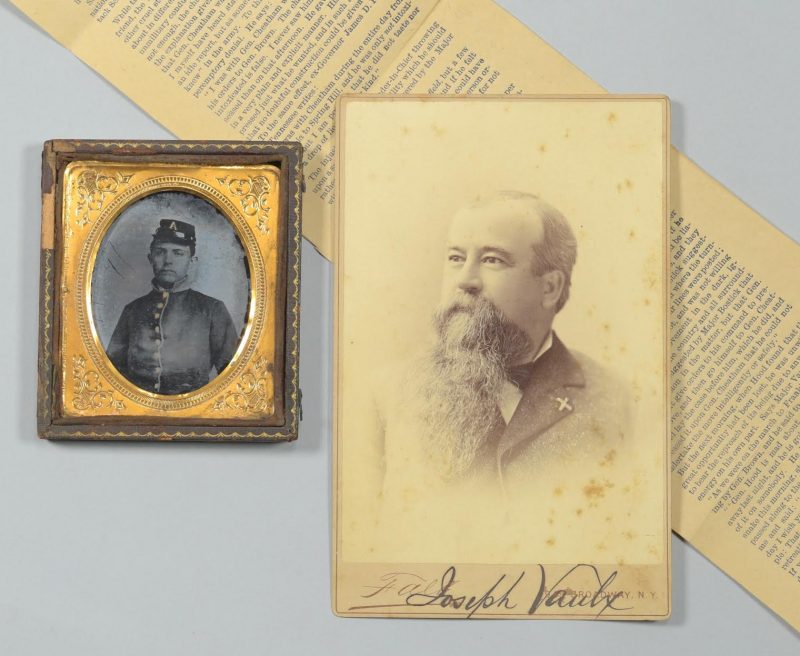 |
|
Three Civil War era items including photographs. 1st item: Cabinet card portrait of Confederate Major Joseph Vaulx, Jr. of Nashville, TN, signed in ink, published by NY society photographer Benjamin “Jack” Falk, 949 Broadway, N.Y. Major Vaulx served under Major General, B. F. Cheatham in several campaigns including the Battle of Franklin. At the close of the war, Major Vaulx went to New York where he worked in the dry goods business for a period of approximately eleven years, 6-1/2″ x 4-3/16″. 2nd item: Ambrotype of Confederate Army of Tennessee Soldier in partial leather embossed case with brass mat. Gold highlights to his kepi and buttons on coat. Mat stamped Worcester, Mass No. 10, Dean & Emerson’s Patent Applied For. 3-3/4″ x 3-1/4″ x 3/8″. 3rd item: Broadside describing leadership conflict at Spring Hill between General Hood and General Cheatham as witnessed by others including Major Vaulx, 19-1/2″ x 3-7/8″, probably a Confederate field printing. Provenance: the estate of Sarah Hunter Hicks Green, formerly of Historic Devon Farm, Nashville, Tennessee. |
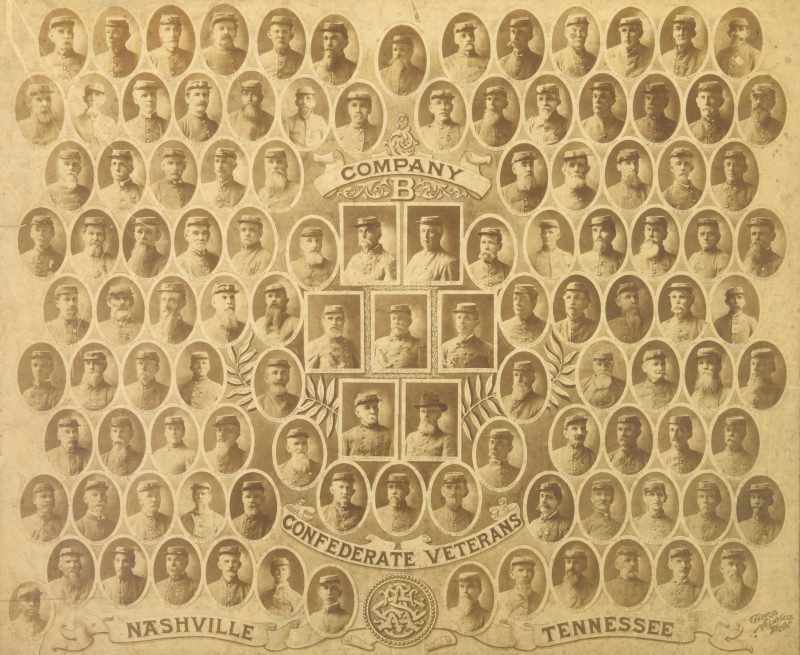 |
|
Circa 1904 Giers photograph of Confederate Veterans of Company B, Nashville, Tennessee including an African American. Among the more than 100 former CSA soldiers pictured are Captain Mark S. Cockrill, Lt. William Aimison, Lt. M.M. Barnes, Lt. Howlette, Quartermaster Spencer Eakin, Chaplain M.B. Pilcher, Surgeon R. J. Neil, and one African-American, Monroe Gooch. 17 1/2″ x 14 5/8″ image. Together with a souvenir ribbon, programme, and souvenir railroad ticket for the United Confederate Veterans Reunion held in Nashville on June 14-16, 1904. Estate of Sarah Hunter Hicks Green, Nashville, TN. |
 |
|
Confederate copy of a Model 1840 heavy dragoon saber with a “Dog River” unstopped fuller blade. Stamped “158” and “XX” on guard. Blade length – 36″. Overall length – 41 1/2″. Found on the property of Devon Farm. Estate of Sarah Hunter Hicks Green, Nashville, TN. |
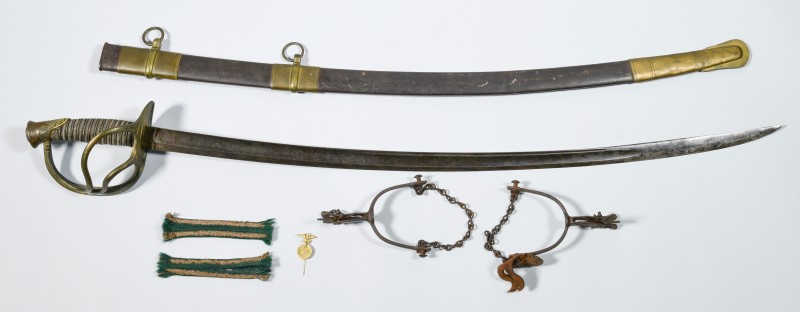 |
|
Confederate Civil War archive belonging to Private John Randolph Zeigler (1833 – 1919) of Franklin County, Virginia. Archive includes: 1st item: Civil War era engraved light cavalry saber with partial floral and shield engraved decoration to the blade, grip with full sharkskin and twisted gilt copper wrap with scabbard, no visible marks but probably Solingen. Blade measures approximately 32″ L. 38″ total L . 2nd item: United Confederate Veteran Reunion Medal from Richmond, May 30 – June 3, 1907. 3rd item: Uniform textile fragment possibly from epaulets comprised of green woven strip bordered by woven gilt threads, both approximately 5 1/4″ L. 4th item: Pair of wrought iron Civil War era spurs with engraved decoration. One retains fragment of the original leather. 5 3/4″ L x 4″ W. History: Zeigler enlisted in the Confederate Army of Virginia in October, 1864. Enlisted in Company E, Virginia 57th Infantry Regiment on 14 Oct 1864. He was captured as a POW in Richmond VA in April 3rd, 1865 and released on July 1st, 1865. |
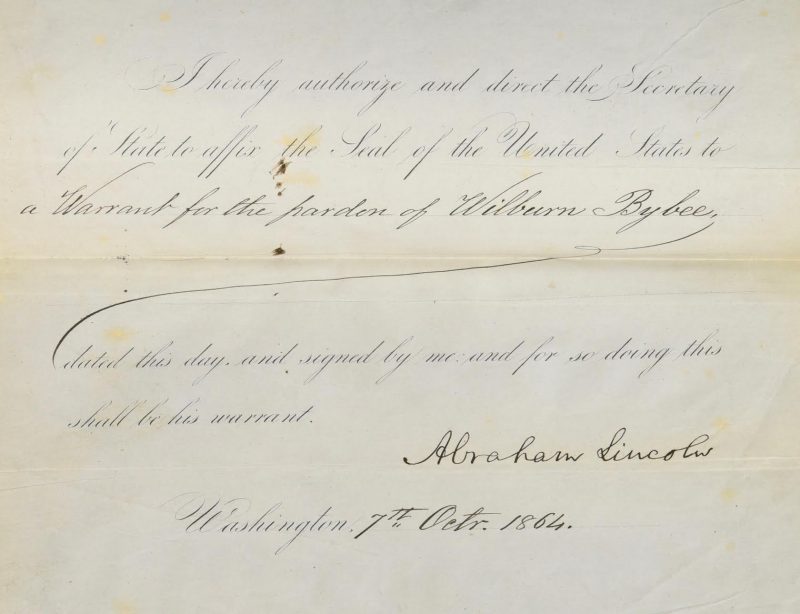 |
|
President Abraham Lincoln signed pardon release order for Wilburn Bybee dated Oct. 7, 1864, partially printed on blue paper, approx. 8″ x 10″, adhered within the book “Abraham Lincoln, A History” by John G. Nicolay and John Hay (New York: The Century Company, 1890; measuring 9″ x 6 1/2″), along with unrelated letters autographed by the books authors. These letters, also adhered to the front leaves, include a hand written note on Supreme Court of the United States letterhead addressed to Harry Hance of West Chester, PA and dated March 11, 1886, reading “My Dear Sir, I regret I am unable to send you an autograph of President Lincoln or to indicate where one could be obtained. Yours Truly, John G. Nicolay”; and a printed note, signed in ink, on Department of State letterhead dated April 6, 1901 and addressed to Fred M. Hopkins of New York, reading “Dear Sir: The address you speak of was published by John Lane in London. I think he also has a publishing office in New York. I am not able to say whether he has any copies of the address on hand. I regret I have none myself. Yours sincerely, John Hay.” A note fully adhered to the front fly leaf from the bookseller Harry E. Davis of Chicago explains that this book was the first of ten volumes of the original 1890 edition of the first book publication of “Abraham Lincoln: A History” by Nicolay and Hay; that the three signed inserts contain original signatures; and that the book was bound in full dark blue Morocco with emblematic tooling to the order of Randall E. Briscoe, Houston, Texas, 1952. John Nicolay (1831-1902) and John Hay (1838-1905) were Lincoln’s private secretaries and biographers. After Lincoln’s assassination, both continued in political careers. Nicolay went on to be Marshall of the U.S. Supreme Court and Hay later became the U.S. Secretary of State under William McKinley and Theodore Roosevelt. Wilburn Bybee of Barren County, Kentucky, was incarcerated for “Robbing the U.S. Mail.” His pardon case file is on record at the National Archives/Library of Congress. |
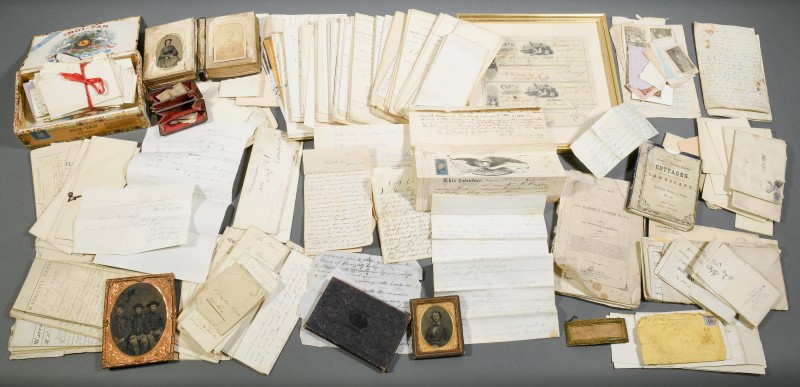 |
|
Extensive Civil War era archive of Captain Jacob Lonas, Company C, 1st Tennessee Cavalry from Knoxville, TN (Bearden). |
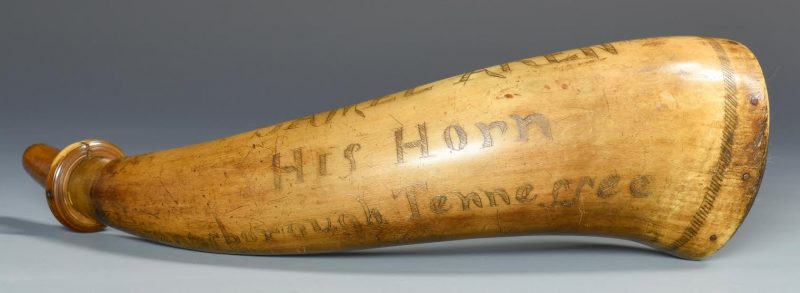 |
|
Early 19th century TN powder horn with etched inscription, “1827 Samel Aken His Horn Jonesborough, Tennessee” and an inscribed fylfot symbol beside the date. Retains the original wood plug. 12 1/4″ outer circumference of longest curve. |
 |
|
Marlin Model 1893 Engraved Special Order Lever Action Rifle, .38-.55 caliber, serial number 139497, under receiver just behind forestock. Figured and flame grain American walnut straight stock with “A” style checking, serpentine pistol grip stock and crescent buttplate. Factory engraving on barrel and receiver including running elk in a circle surrounded by scroll and border engraving on left side of receiver, and standing buck deer in a circle surrounded by scroll and border engraving on right side. 26″ octagon to round barrel stamped , MARLIN FIRE-ARMS CO. NEW-HAVEN, CT. U.S.A. PATENTED. OCT. 11. 1887. APRIL 2. 1889. AUGUST 1. 1893. Adjustable sight stamped MARBLE’S GLADSTONE MICH. U.S.A. Lyman front sight stamped PAT. JAN. 29. 79 – MAY. 6. 87. Overall length – 44 5/8″. Serial number corresponds with the year 1896. and tan snakeskin case included. |
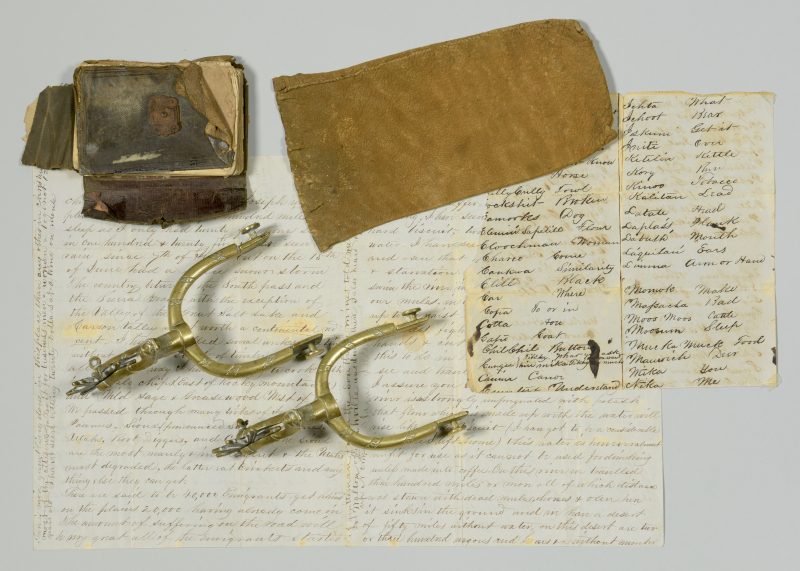 |
|
Approximately 10 items including Gold Rush Related Pocket diary belonging to Edward Dickson Hicks II (b. 1831- d. 1894), beginning Jan. 1, 1850, at his home Devon Farm in Nashville, Tennessee. Entry March 13, 1850: “Have the California Fever on the high order. I am resolved to go.” Runs through April 1851, describes his journey in detail. Notes of purchases in back of book (and one page that has come loose) including a mule for $40, whip lash, harness, etc. Note that the diary does not describe his return home, and the entries, which are in pencil near the end, become progressively lighter and harder to read. Also included are a scrap of paper with reference to a Trading Expedition in 1851 and two pages labeled by Hicks’ great granddaughter Sarah Hunter Hicks Green as “Translations of Shoshonis Indian Tribe Language by Ed Hicks II – he kept this folded up in his diary.” Pocket diary 4″ x 2 1/2″. This archive also includes a letter from Ed Hicks II to Alexander C. Robertson, written in Sacramento City Calif. Aug. 4, 1850, describing his journey from the St. Joseph area. “The amount of suffering on the road will be very great all of the emmigrants started from the states with light loads of provisions and expecting to make short trips but all are doomed to disappointment, and as men on the plains eat twice as much as they do at home they are sure to get out of food. I have seen men offer one dollar for a hard biscuit, two dollars for three pints of water.” Also included is Hicks’ leather “bullet bag” mentioned in his diary on March 17, 1850 (“Horton presented me a Bible, Bullet bag”). The lot also includes a pair of Spanish or Mexican brass spurs, figural decoration, 1-7/8″ rowels, 6″ L x 3″ W x 2-3/8″ D, circa 1840, that Ed Hicks, II, wore when he went west for the Gold Rush, and a family archival photo (8 1/4″ x 10″) of the same spurs together with his pistols. |
 |
|
Antique Persian Talish runner, wool on wool, blue center field, secondary colors of red, ivory, brown, gold, blues, yellow, rust and purple. Dated backwards and signature backwards, possibly copied from an earlier version. A. Morjikian, NYC retailer label on back. 2’11” x 11’9″. c. 1900. |
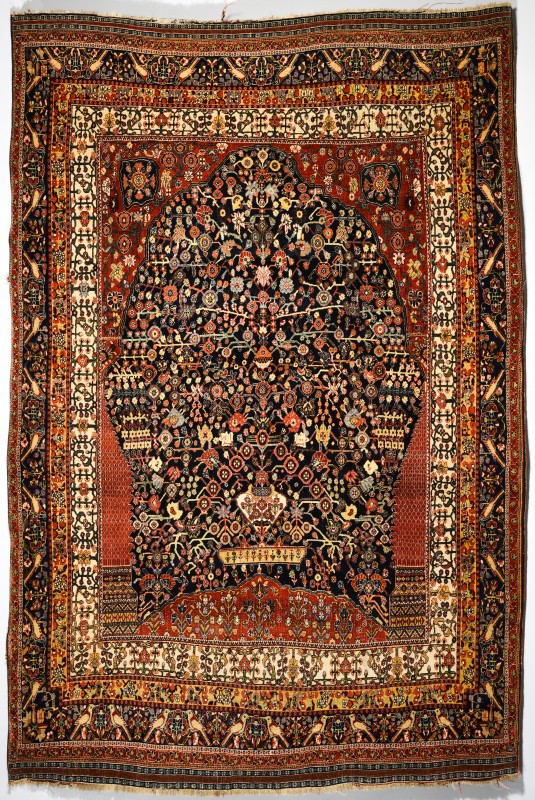 |
|
Vintage Persian Qashquai area rug, wool on linen, Tree of Life pattern, colors of navy, red, gold, ivory, green and black. Birds and berries in primary border. Black and ivory and red and green end borders. Custom’s tag stapled on back, 5’1″ x 7’8″. c 1930. |
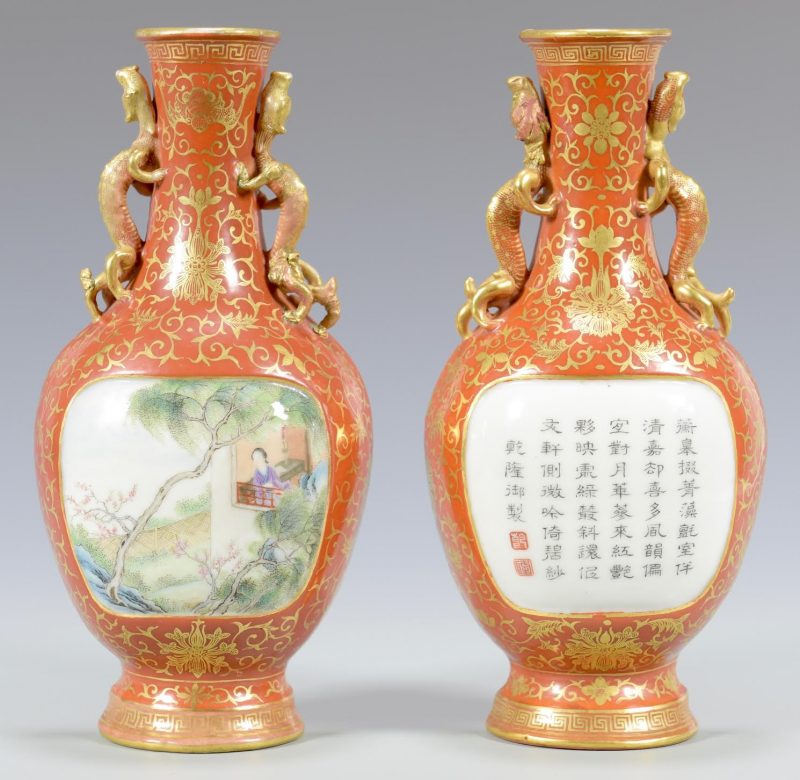 |
|
Pair of Chinese porcelain wall pockets having iron oxide and floral gilt grounds, figural dragon handles, robin’s egg blue interiors and central enamel cartouche decoration, one depicting a beauty seated by a balcony window overlooking a landscape scene, the other with Chinese poem and two red seals stating that the pockets were made during the Qianlong Emperor reign. Qianlong seal form marks in gilt to the bases. 7 7/8″ H. |
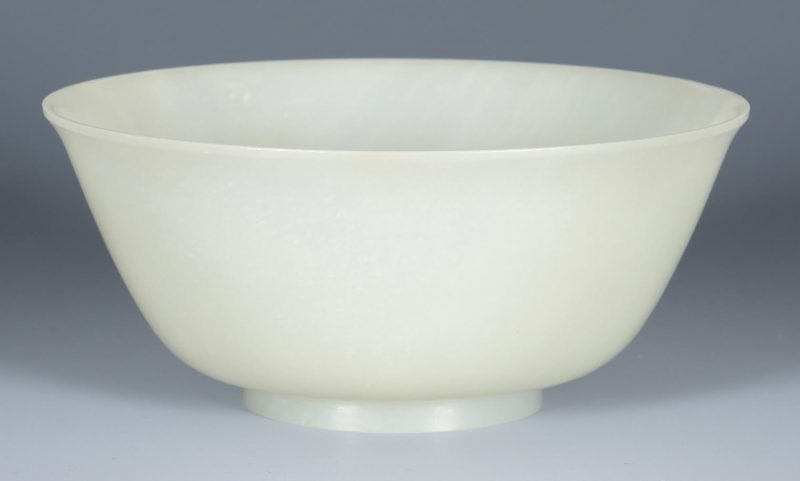 |
|
Chinese White Jade Bowl, Ch’ien Lung, inverted bell-shaped form atop a short, slightly splayed foot ring. 6-3/4″ diameter by 2-15/16″ H. Qing Dynasty, Ch’ien Lung Period, mid to late 18th century. Provenance: The collection/estate of Mr. and Mrs. W. Jeter Eason, Memphis, by descent to present consignor. Note: This is the companion bowl to one sold at our July, 2016 auction. This bowl is being consigned by another member of the same family. It is a slightly larger size. |
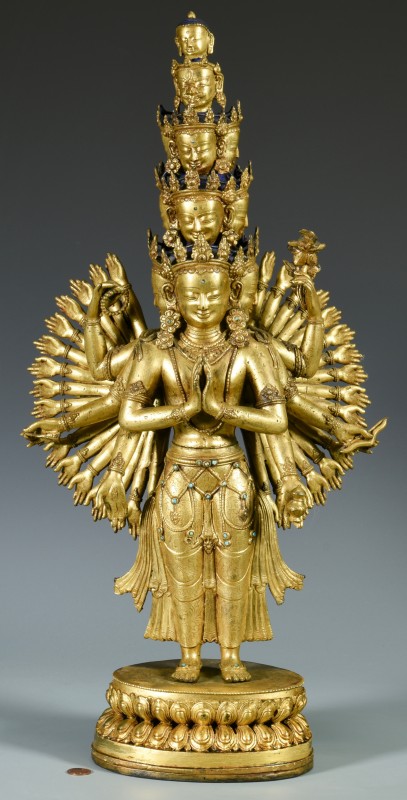 |
|
Gilt Bronze Tibetan Avalokiteshvara sectional sculpture depicted with 11 faces and 42 arms with jeweled accents and applied blue pigment to hair standing atop a double lotus pedestal base. 23 3/4″ H x 11 3/4″ W. |
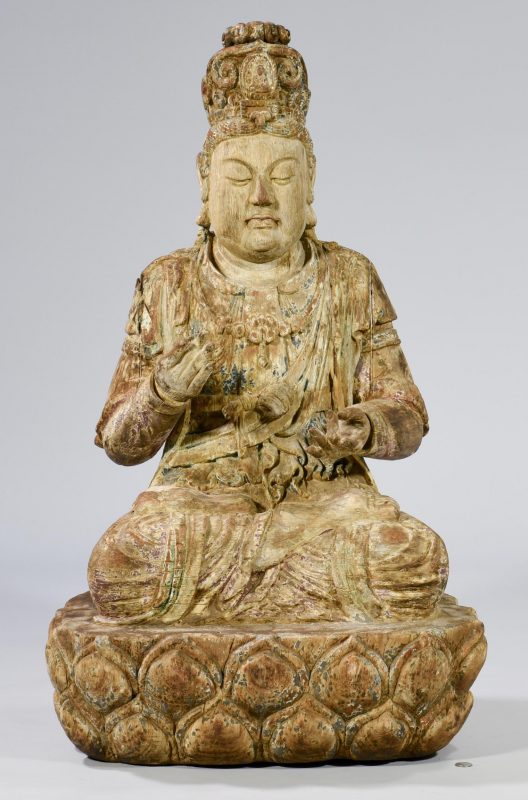 |
|
Large Chinese Quan Yin carved wood temple figure on a lotus base with hands in the teaching position (vitarka) mudra and legs in full lotus position, remnants of polychrome paint throughout. 41 1/2″ H. Late 18th/Early 19th century. |
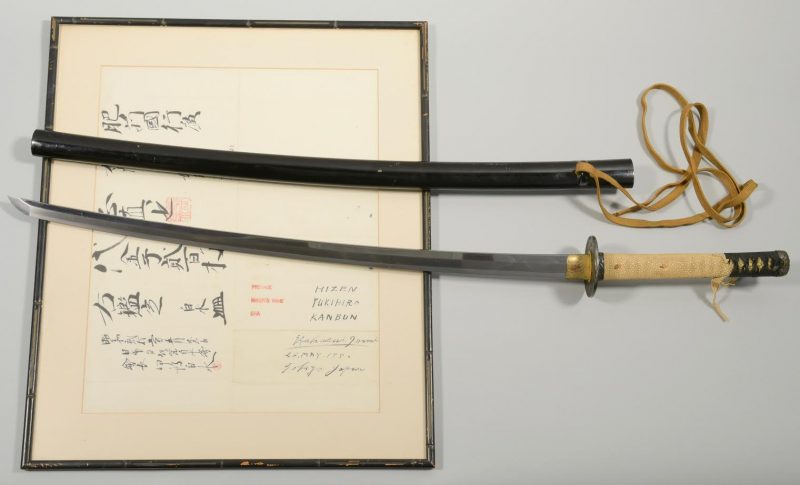 |
|
Japanese Kanbun-Shinto period (1658 -1683) samurai sword made by 1st generation Kuni Yukihiro in the Hizen province. Iron Maru Gata tsuba with engraved landscape decoration. Bronze engraved Kashira (endcap) and Fuchi (collar) both with engraved wave decoration. Black lacquered saya or scabbard and partially bound ray skin handle. An authentication document of the sword dated May 26, 1950 by Hakusui Inami of the Japanese Sword Research Institute accompanies this lot. (24 3/4″ H x 20 3/4″ W). Blade measures 30 3/4″ L. 41 1/2″ total length.
|
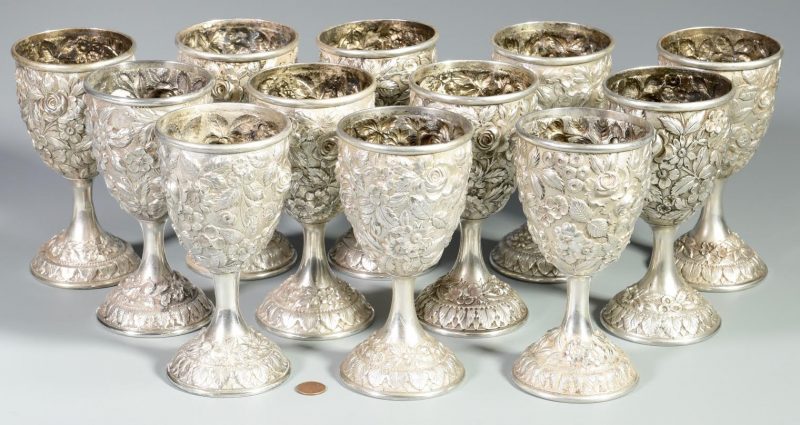 |
|
Set of twelve (12) Baltimore Silversmiths Mfg. Co. or Schofield sterling silver repousse goblets, Baltimore Rose pattern, having deep relief carved floral decoration featuring roses to the bowls and base. Signed on the base with Baltimore Silversmiths hallmarks and impressed “163” and “BaltoRose”. Each measuring 6 3/4″ H. 81.675 total troy ounces. Circa 1903-1905. |
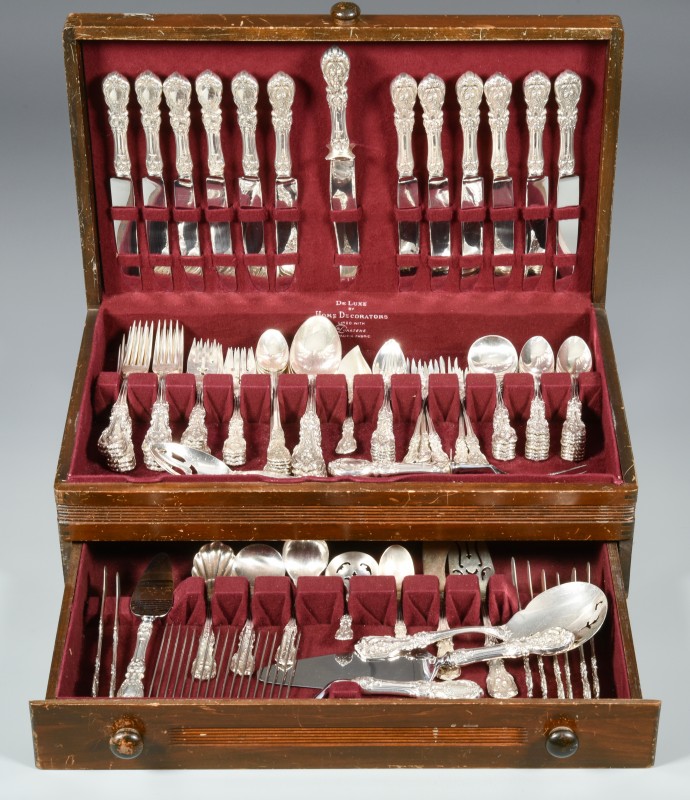 |
|
Reed and Barton sterling silver flatware set, Francis 1st pattern, established 1907, 106 pieces, mixed dates of manufacture, consisting of 12 dinner knives (9-1/8″ L), 12 dinner forks (7-1/4″ L), 10 salad forks, 16 teaspoons, 7 round soup spoons (5-7/8″ L), 7 iced teaspoons, 7 oyster/cocktail forks, 8 flat butter spreaders, 6 fruit spoons, 2 demitasse spoons, 4 table spoons (8-3/8″ L ea), 1 pierced table spoon, 1 cold meat fork, 1 tomato server, 1 olive/pickle fork, 1 pierced bon bon spoon, 1 master butter spreader, 1 jelly server, 1 sugar shell, 1 cream/sauce ladle, 1 baby spoon, 2-piece carving set with guards, 1 pie server, 1 cheese server and 1 cake breaker (10-1/2″ L). 120.85 weighable oz troy. No monograms. Lot includes wooden storage case. |
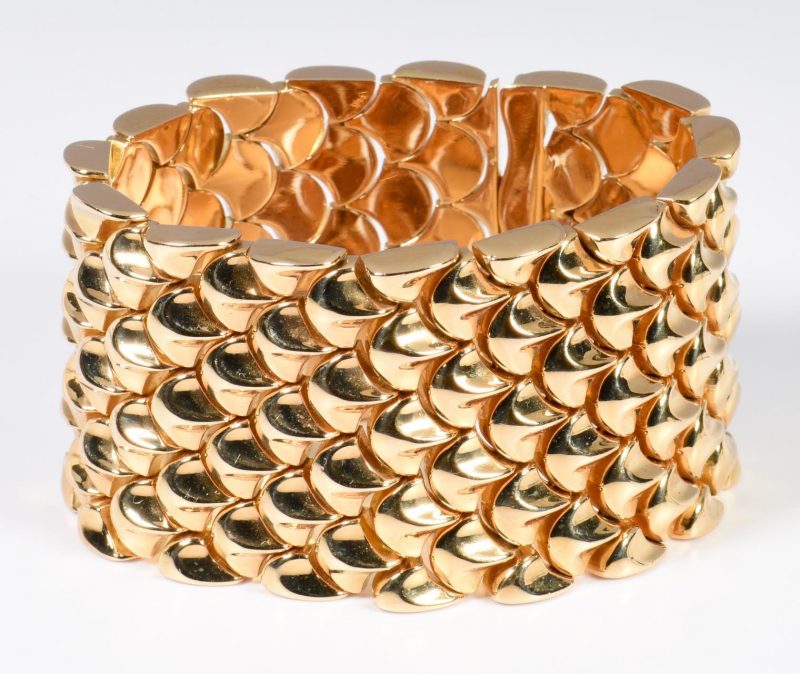 |
|
Italian 18K gold bracelet, 90.7 grams total. |
 |
|
Large selection of platinum and precious stone eternity rings. |
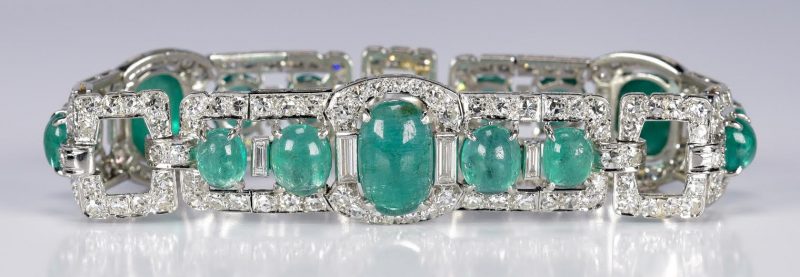 |
|
Platinum Art Deco emerald and diamond bracelet containing 15 cabochon cut emeralds of varying sizes with a total weight of approximately 15 cts and 12 straight baguette diamonds and 168 single cut diamonds with a total weight of approximately 6.25 cts, J-K color, SI clarity. 6-7/8″ L x 11/16″ H with safety chain. Platinum not marked but tested. 38.9 grams. |
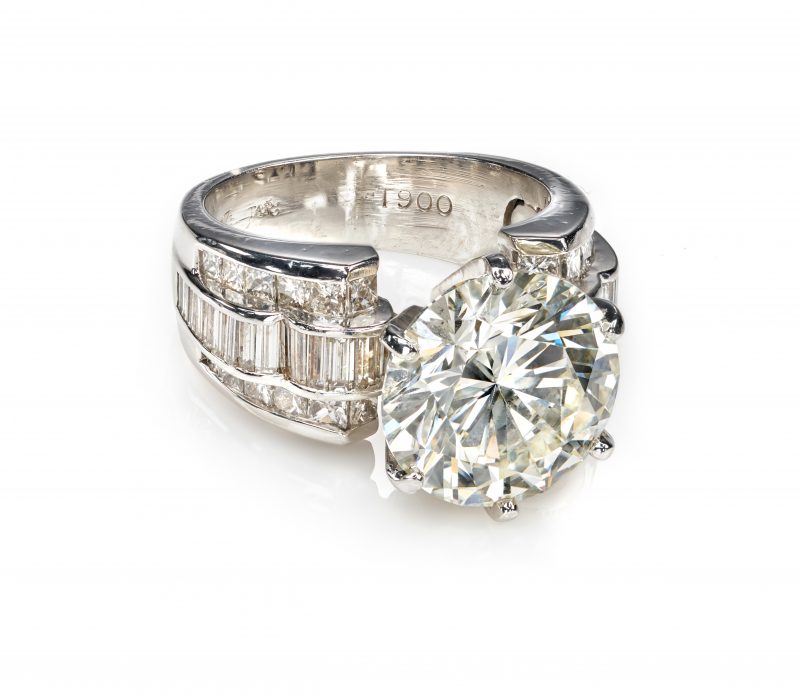 |
|
8.03 round brilliant diamond set in platinum and diamond fashion ring, GIA report number 2173543789, dated March 22, 2016, stating J color, SI2 clarity, 12.88 – 13.01 x 7.85 mm measurements, Very good cut, Good polish, Very good symmetry and No fluorescence. The JB Star handmade mounting contains 24 princess cut diamonds and 34 straight baguette diamonds channel set with a total weight of approximately 1.84 cts., approximately VS clarity and G-H color. Molded in the inside of each shank are the initials “JBS” for JB Star. Ring size 7 3/4. 19.4 grams. Provenance: Estate of Sarah Hunter Hicks Green, Nashville, Tennessee. |
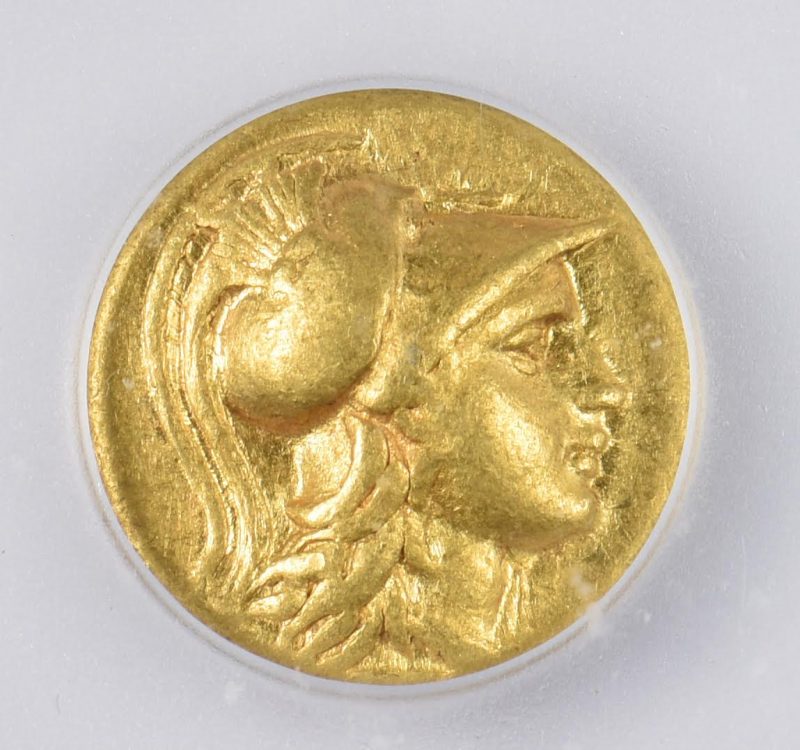 |
|
Several graded ancient gold staters to be offered from a Chattanooga estate. |
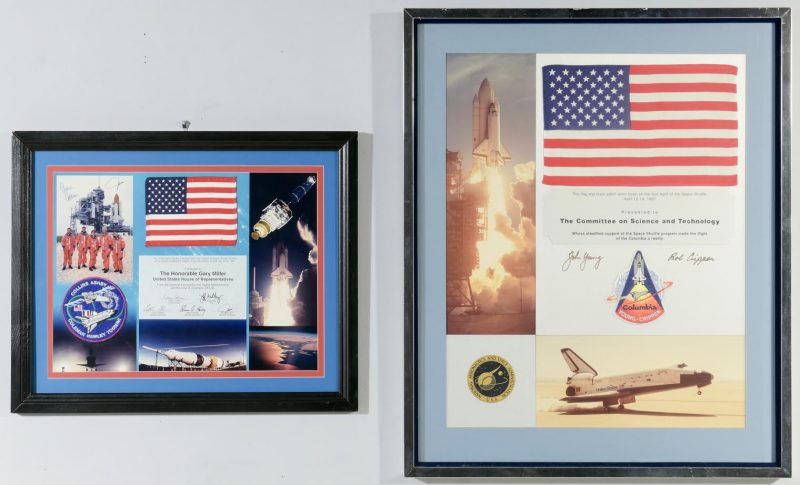 |
|
2 Framed Space Shuttle Columbia Crew Patches and Flags, with astronaut autographs. 1st item: Space Shuttle Columbia Crew Patch with embroidered insignia, and 12″ x 7″ Flag, flown on the first flight of the Space Shuttle, April 12-14, 1981, adhered to board with printed presentation inscription “to the Committee on Science and Technology, whose steadfast support of the Space Shuttle Program made the flight of the Columbia a reality.” Autographed by John Young and Bob Crippen, with photographs of the shuttle taking off and landing and a NASA badge. 29″ x 24″ overall. 2nd item: Space Shuttle Columbia Crew Patch and 4 1/2″ x 5 1/2″ Flag, flown on the shuttle’s mission to deploy the Chandra X-Ray Observatory, STS-93, July 23-27, 1999. Photograph of the Shuttle Crew, with autographs of Commander Eileen Collins and specialist Michael Tognini, along with printed versions of autographs by five crew members and three related photographs. 17 1/2″ x 21 1/2″ overall. History: “A new era in space flight began on April 12, 1981, when Space Shuttle Columbia, or STS-1, soared into orbit from NASA’s Kennedy Space Center in Florida. Astronaut John Young, a veteran of four previous spaceflights including a walk on the moon in 1972, commanded the mission. Navy test pilot Bob Crippen piloted the mission and would go on to command three future shuttle missions. The shuttle was humankind’s first re-usable spacecraft. Named after the first American ocean vessel to circle the globe and the command module for the Apollo 11 Moon landing, Columbia continued this heritage of intrepid exploration. Perhaps Columbia’s crowning achievement was the deployment of the gleaming Chandra X-ray Observatory in July 1999. Carried into space inside the orbiter’s payload bay, the slender and elegant Chandra telescope was released on July 23. Still in flight today, the X-ray telescope specializes in viewing deep space objects and finding the answers to astronomy’s most fundamental questions. Columbia and its crew were tragically lost during STS-107. As the Space Shuttle lifted off from Kennedy Space Center in Florida on January 16, 2003, a small portion of foam broke away from the orange external fuel tank and struck the orbiter’s left wing. The resulting damage created a hole in the wing’s leading edge, which caused the vehicle to break apart during reentry to Earth’s atmosphere on February 1, 2003.” – source: excerpted from NASA.gov. Provenance: collection of a US Naval Officer, given to him as a gift. |
|
|
|
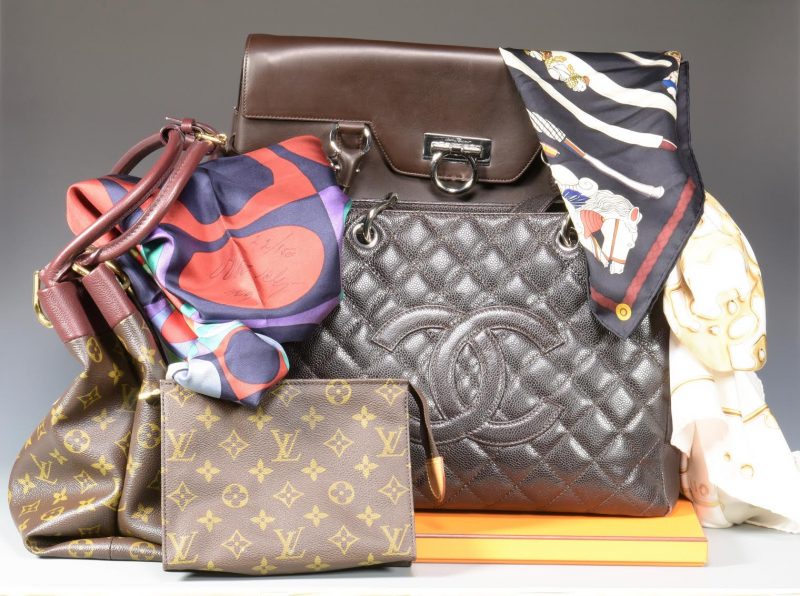 |
|
Large selection of Fashion items including Chanel, Louis Vuitton, Hermes, Ferragamo, and Burberry. |
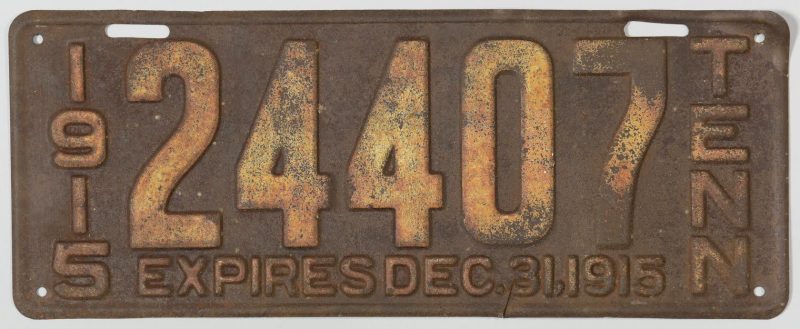 |
|
An early metal State of Tennessee issued license plate reading “1915/24407/TENN/EXPIRES DEC. 31, 1915”. 5 7/8″ H X 15″W. Note: 1915 is the first year Tennessee issued a state license plate. They were one of the first states to regulate plates and early examples are very desirable. License plate is original condition. Remaining paint is original. |